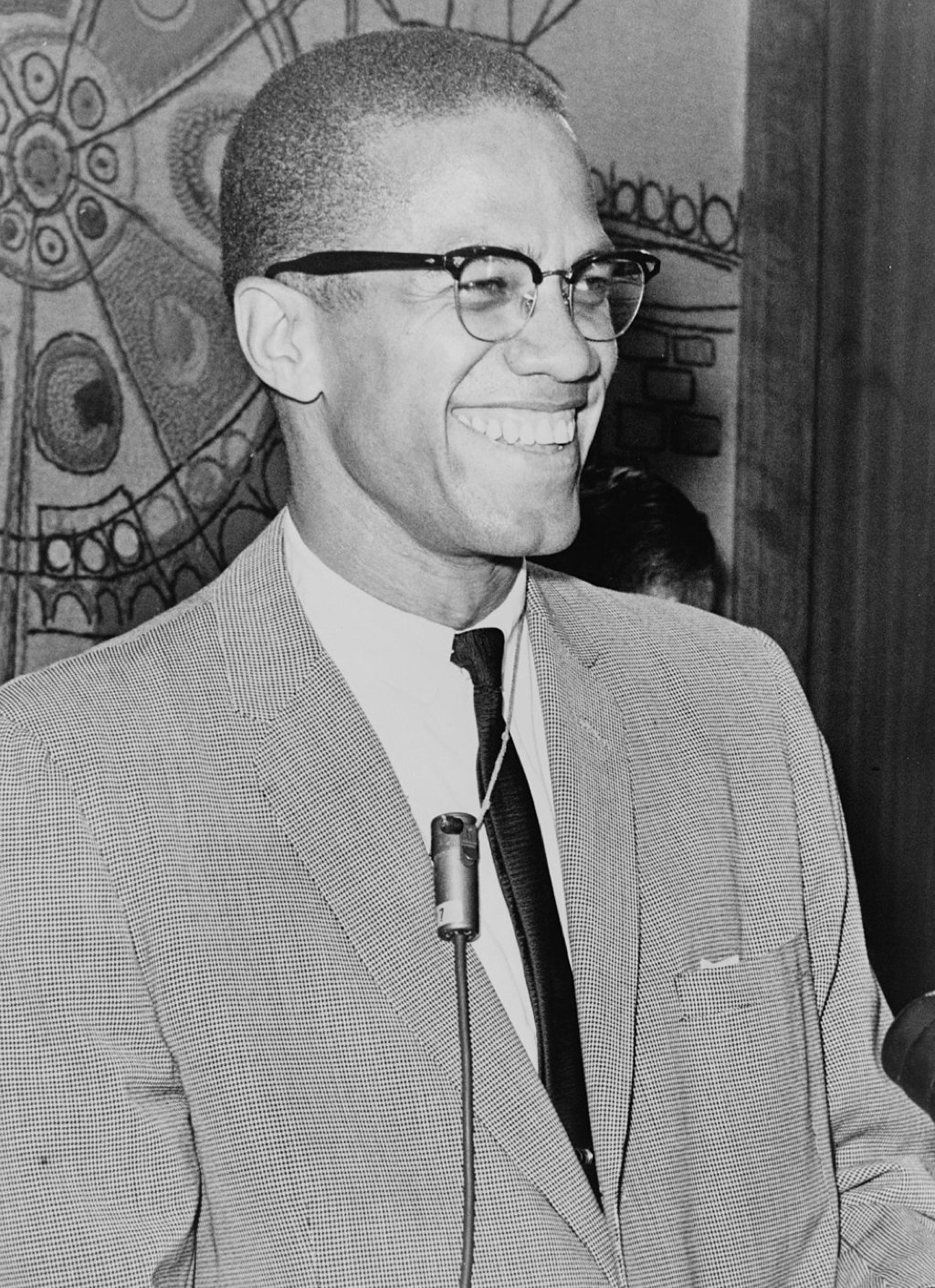
マルコム X
Malcolm X, 1925-1975

Malcolm X in March 1964
☆ マルコムX(Malcolm X;マルコム・リトル、後のエル=ハジ・マリク・エル=シャバズ、1925年5月19日-1965年2月21日)はアフリカ系アメリカ人の革命 家、イスラム教の牧師、人権活動家で、公民権運動で著名な人物であった。1964年まで「ネーション・オブ・イスラム(NOI)」のスポークスマンを務 め、黒人のエンパワーメントとアフリカ系アメリカ人コミュニティにおけるイスラム教の普及を声高に主張した。1965年、アレックス・ヘイリーとの共著に よる自伝が出版された。人種差別と暴力を説いたと非難され、物議を醸したマルコムXは、人種的正義を追求したことで、アフリカ系アメリカ人やイスラム系アメリカ人のコミュニティ で広く称賛された人物でもある。マルコムXは死後、全米のさまざまな都市で記念日「マルコムXデー」が制定された。また、彼が暗殺された場所であるオー デュボン・ボールルームは、2005年に一部が再開発され、マルコムXとベティ・シャバズ博士記念教育センターが建設された。
| Malcolm X
(born Malcolm Little, later el-Hajj Malik el-Shabazz; May 19, 1925 –
February 21, 1965) was an African-American revolutionary, Muslim
minister and human rights activist who was a prominent figure during
the civil rights movement. A spokesman for the Nation of Islam (NOI)
until 1964, he was a vocal advocate for Black empowerment and the
promotion of Islam within the African-American community. A posthumous
autobiography, on which he collaborated with Alex Haley, was published
in 1965. Malcolm spent his adolescence living in a series of foster homes or with relatives after his father's death and his mother's hospitalization. He committed various crimes, being sentenced to 8 to 10 years in prison in 1946 for larceny and burglary. In prison, he joined the Nation of Islam, adopting the name Malcolm X to symbolize his unknown African ancestral surname while discarding "the white slavemaster name of 'Little'", and after his parole in 1952 quickly became one of the organization's most influential leaders. He was the public face of the organization for 12 years, advocating Black empowerment and separation of Black and White Americans, and criticizing Martin Luther King Jr. and the mainstream civil rights movement for its emphasis on non-violence and racial integration. Malcolm X also expressed pride in some of the Nation's social welfare achievements, such as its free drug rehabilitation program. From the 1950s onward, Malcolm X was subjected to surveillance by the Federal Bureau of Investigation (FBI). In the 1960s, Malcolm X began to grow disillusioned with the Nation of Islam, as well as with its leader, Elijah Muhammad. He subsequently embraced Sunni Islam and the civil rights movement after completing the Hajj to Mecca and became known as "el-Hajj Malik el-Shabazz," which roughly translates to "The Pilgrim Malcolm the Patriarch". After a brief period of travel across Africa, he publicly renounced the Nation of Islam and founded the Islamic Muslim Mosque, Inc. (MMI) and the Pan-African Organization of Afro-American Unity (OAAU). Throughout 1964, his conflict with the Nation of Islam intensified, and he was repeatedly sent death threats. On February 21, 1965, he was assassinated in New York City. Three Nation members were charged with the murder and given indeterminate life sentences. In 2021, two of the convictions were vacated. Speculation about the assassination and whether it was conceived or aided by leading or additional members of the Nation, or with law enforcement agencies, has persisted for decades. A controversial figure accused of preaching racism and violence, Malcolm X is also a widely celebrated figure within African American and Muslim American communities for his pursuit of racial justice. He was posthumously honored with Malcolm X Day, on which he is commemorated in various cities across the United States. Hundreds of streets and schools in the U.S. have been renamed in his honor, while the Audubon Ballroom, the site of his assassination, was partly redeveloped in 2005 to accommodate the Malcolm X and Dr. Betty Shabazz Memorial and Educational Center. |
マ
ルコムX(Malcolm X;マルコム・リトル、後のエル=ハジ・マリク・エル=シャバズ、1925年5月19日-1965年2月21日)はアフリカ系アメリカ人の革命家、
イスラム教の牧師、人権活動家で、公民権運動で著名な人物であった。1964年まで「ネーション・オブ・イスラム(NOI)」のスポークスマンを務め、黒
人のエンパワーメントとアフリカ系アメリカ人コミュニティにおけるイスラム教の普及を声高に主張した。1965年、アレックス・ヘイリーとの共著による自
伝が出版された。 マルコムは、父親の死と母親の入院の後、一連の養護施設や親戚のもとで思春期を過ごした。さまざまな犯罪を犯し、1946年には窃盗と強盗で8年から10 年の実刑判決を受けた。刑務所の中で、彼は「リトル」という白人の奴隷支配者の名前を捨て、アフリカの祖先の不明な姓を象徴するマルコムXという名前を採 用し、イスラム教国に加入した。彼は12年間にわたり組織の顔として、黒人の地位向上と黒人と白人の分離を主張し、非暴力と人種統合を強調するマーティ ン・ルーサー・キング・ジュニアと公民権運動の主流を批判した。マルコムXはまた、無料の薬物リハビリテーション・プログラムなど、ネーションズの社会福 祉の成果にも誇りを示した。1950年代以降、マルコムXは連邦捜査局(FBI)の監視下に置かれた。 1960年代、マルコムXはイスラム国やその指導者イライジャ・ムハンマドに幻滅し始めた。その後、彼はメッカへのハッジを終えた後、スンニ派イスラム教 と公民権運動を受け入れ、「el-Hajj Malik el-Shabazz」(大まかに訳すと 「巡礼者マルコム・ザ・パトリアーク」)として知られるようになった。アフリカを短期間旅行した後、彼はイスラム国家を公に放棄し、イスラム・ムスリム・ モスク社(MMI)とアフリカ系アメリカ人統一汎アフリカ組織(OAAU)を設立した。1964年を通じて、イスラム教国との対立は激化し、彼は何度も殺 害予告を送られた。1965年2月21日、彼はニューヨークで暗殺された。3人のネーションメンバーが殺人罪で起訴され、不定期の終身刑が言い渡された。 2021年、2人の有罪判決が取り消された。暗殺について、またそれがネーションの主要メンバーやその他のメンバー、あるいは法執行機関によって企てられ たのか、あるいは手助けされたのかどうかについての憶測は、何十年も続いている。 人種差別と暴力を説いたと非難され、物議を醸したマルコムXは、人種的正義を追求したことで、アフリカ系アメリカ人やイスラム系アメリカ人のコミュニティ で広く称賛された人物でもある。マルコムXは死後、全米のさまざまな都市で記念日「マルコムXデー」が制定された。また、彼が暗殺された場所であるオー デュボン・ボールルームは、2005年に一部が再開発され、マルコムXとベティ・シャバズ博士記念教育センターが建設された。 |
Early years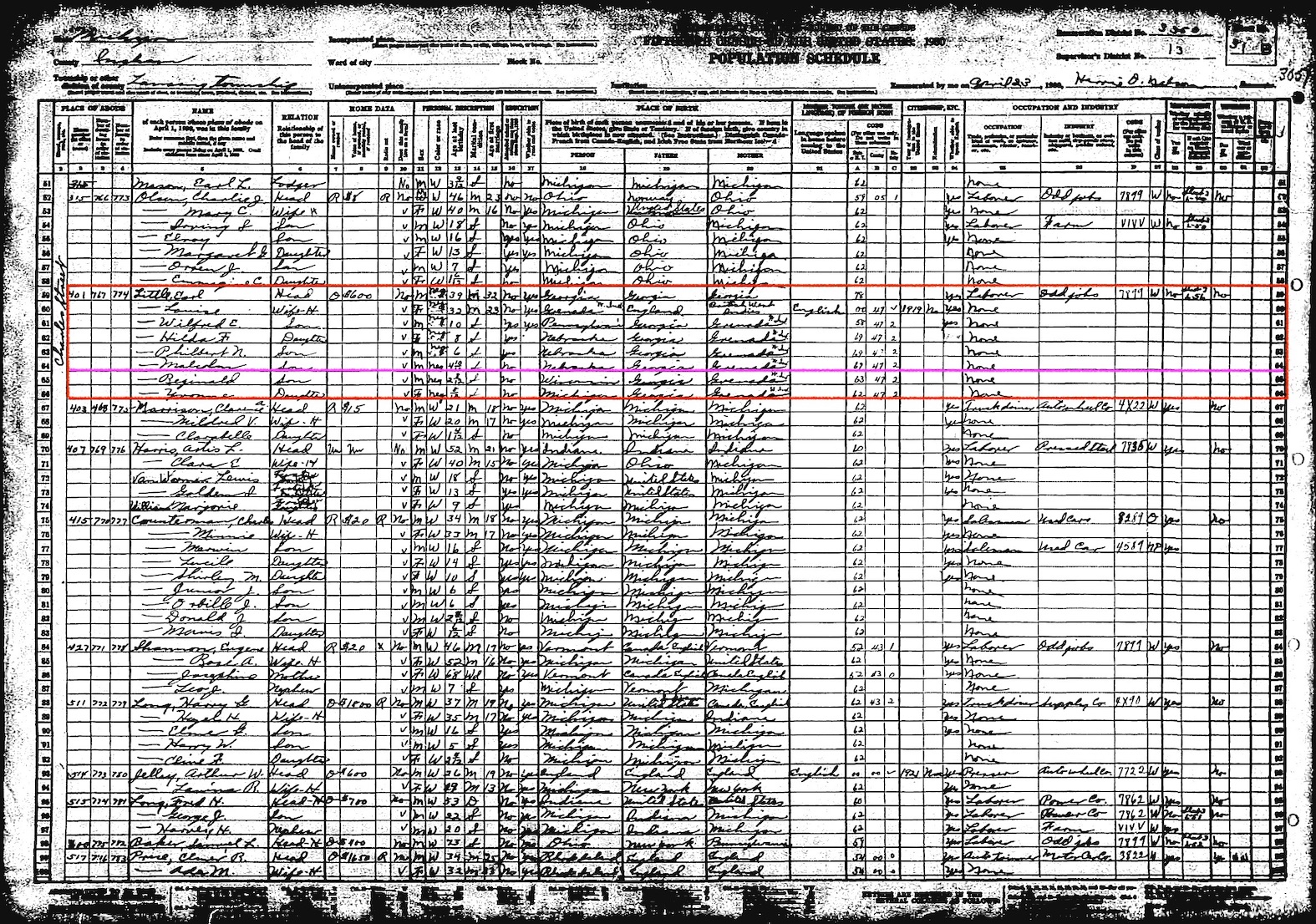 A ledger with names, ages, and other personal information A 1930 United States Census return listing the Little family (lines 59ff) Malcolm Little was born May 19, 1925, in Omaha, Nebraska, the fourth of seven children of Grenada-born Louise Helen Little (née Langdon) and Georgia-born Earl Little.[2] Earl was an outspoken Baptist lay speaker, and he and Louise were admirers of Pan-African activist Marcus Garvey. Earl was a local leader of the Universal Negro Improvement Association (UNIA) and Louise served as secretary and "branch reporter", sending news of local UNIA activities to Negro World; they inculcated self-reliance and black pride in their children.[3][4][5] Malcolm X later said that White violence killed four of his father's brothers.[6] Because of Ku Klux Klan threats, Earl's UNIA activities were said to be "spreading trouble"[7] and the family relocated in 1926 to Milwaukee, and shortly thereafter to Lansing, Michigan.[8] There, the family was frequently harassed by the Black Legion, a White racist group Earl accused of burning their family home in 1929.[9] When Malcolm was six, his father died in what has been officially ruled a streetcar accident, though his mother Louise believed Earl had been murdered by the Black Legion. Rumors that White racists were responsible for his father's death were widely circulated and were very disturbing to Malcolm X as a child. As an adult, he expressed conflicting beliefs on the question.[10] After a dispute with creditors, Louise received a life insurance benefit (nominally $1,000 —about $20,000 in 2023)[A] in payments of $18 per month;[11] the issuer of another, larger policy refused to pay, claiming her husband Earl had committed suicide.[12] To make ends meet, Louise rented out part of her garden, and her sons hunted game.[11] During the 1930s, white Seventh-day Adventists witnessed to the Little family; later on, Louise Little and her son Wilfred were baptized into the Seventh-day Adventist Church. Malcolm said the Adventists were "the friendliest white people I had ever seen."[13] In 1937, a man Louise had been dating—marriage had seemed a possibility—vanished from her life when she became pregnant with his child.[14] In late 1938, she had a nervous breakdown and was committed to Kalamazoo State Hospital. The children were separated and sent to foster homes. Malcolm and his siblings secured her release 24 years later.[15][16] Malcolm attended West Junior High School in Lansing and then Mason High School in Mason, Michigan, but left high school in 1941, before graduating.[17] He excelled in junior high school but dropped out of high school after a White teacher told him that practicing law, his aspiration at the time, was "no realistic goal for a nigger."[18] Later, Malcolm X recalled feeling that the White world offered no place for a career-oriented Black man, regardless of talent.[18] 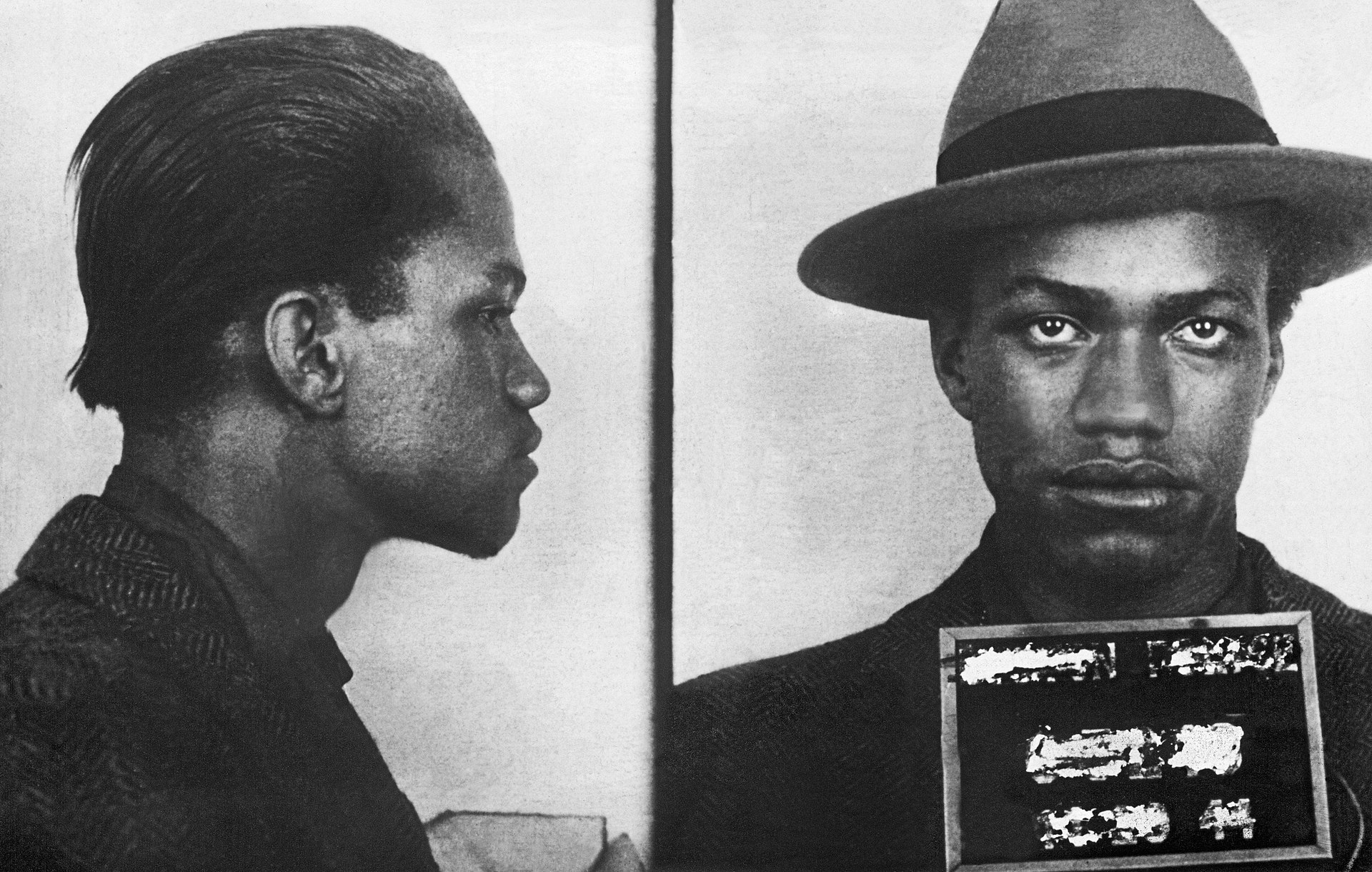 A Boston police mug shot of Malcolm, following his arrest for larceny (1944)[19] From age 14 to 21, Malcolm held a variety of jobs while living with his half-sister Ella Little-Collins in Roxbury, a largely African American neighborhood of Boston.[20][21] After a short time in Flint, Michigan, he moved to New York City's Harlem neighborhood in 1943, where he found employment on the New Haven Railroad and engaged in drug dealing, gambling, racketeering, robbery, and pimping.[22] According to biographer Bruce Perry, Malcolm also occasionally had sex with other men, usually for money, though this conjecture has been disputed by those who knew him.[23][24][B] He befriended John Elroy Sanford, a fellow dishwasher at Jimmy's Chicken Shack in Harlem who aspired to be a professional comedian. Both men had reddish hair, so Sanford was called "Chicago Red" after his hometown, and Malcolm was known as "Detroit Red". Years later, Sanford became famous as comedian and actor Redd Foxx.[32] Summoned by the local draft board for military service in World War II, he feigned mental disturbance by rambling and declaring: "I want to be sent down South. Organize them nigger soldiers ... steal us some guns, and kill us [some] crackers".[33][34][35] He was declared "mentally disqualified for military service".[33][34][35] In late 1945, Malcolm returned to Boston, where he and four accomplices committed a series of burglaries targeting wealthy White families.[36] In 1946, he was arrested while picking up a stolen watch he had left at a shop for repairs,[37] and in February began serving a sentence of eight to ten years at Charlestown State Prison for larceny and breaking and entering.[38] Two years later, Malcolm was transferred to Norfolk Prison Colony (also in Massachusetts).[39][40] |
初期 名前、年齢、その他の個人情報が記載された台帳 リトル一家が記載された1930年合衆国国勢調査報告書(59ff行目) マルコム・リトルは1925年5月19日、ネブラスカ州オマハで、グレナダ生まれのルイーズ・ヘレン・リトル(旧姓ラングドン)とジョージア生まれのアー ル・リトルの7人兄弟の4番目として生まれた[2]。アールは率直なバプティストの信徒演説者で、彼とルイーズは汎アフリカ活動家マーカス・ガーヴィーの 崇拝者であった。アールはユニバーサル・ニグロ・インプルーブメント・アソシエーション(UNIA)の地元のリーダーであり、ルイーズは秘書兼「支部記 者」として地元のUNIAの活動のニュースをニグロ・ワールドに送っていた。 クー・クラックス・クランの脅威のため、アールのUNIA活動は「問題を広めている」と言われ[7]、一家は1926年にミルウォーキーに、その後すぐに ミシガン州ランシングに移住した[8]。そこで一家は、アールが1929年に実家を燃やしたと告発した白人の人種差別主義者グループ、ブラック・レギオン から頻繁に嫌がらせを受けた[9]。 マルコムが6歳のとき、父親は路面電車の事故で死亡したが、母親のルイーズはアールが黒人軍団に殺害されたと信じていた。父親の死は白人の人種差別主義者 のせいだという噂が広く流布し、子供だったマルコムXは非常に心を揺さぶられた。債権者との争いの末、ルイーズは生命保険金(公称1,000ドル ╱2023年には約20,000ドル)を月18ドルの支払いで受け取った[A]。 その後、ルイーズ・リトルと息子のウィルフレッドはセブンスデー・アドベンチスト教会の洗礼を受けた。マルコムは、アドヴェンティストたちは「今まで見た中で最も友好的な白人たちだった」と語っている[13]。 1937年、ルイーズが交際していた男性(結婚の可能性があった)が、彼の子供を妊娠したことでルイーズの人生から姿を消した。子供たちは引き離され、里親のもとに送られた。マルコムと彼の兄弟は24年後に彼女を釈放させた[15][16]。 マルコムは、ランシングのウェスト中学校とミシガン州メイソンのメイソン高校に通ったが、1941年に卒業する前に高校を中退した[17]。 中学校では優秀だったが、当時彼が志していた弁護士業は「黒人にとって現実的な目標ではない」と白人の教師に言われ、高校を中退した[18]。  窃盗で逮捕されたマルコムのボストン警察の顔写真(1944年)[19]。 14歳から21歳まで、マルコムはボストンのアフリカ系アメリカ人が多く住むロックスベリーで異母姉のエラ・リトル=コリンズと暮らしながら様々な仕事を経験した[20][21]。 ミシガン州フリントでしばらく過ごした後、1943年にニューヨークのハーレム地区に移り住み、ニューヘイブン鉄道で職を見つけ、麻薬取引、ギャンブル、 恐喝、強盗、ポン引きなどに従事した。 [22]伝記作家のブルース・ペリーによれば、マルコムは時折他の男ともセックスをし、たいていは金のためだったというが、この推測は彼を知る人々によっ て異論がある[23][24][B]。 彼はハーレムのジミーズ・チキン・シャックの皿洗い仲間で、プロのコメディアンを目指していたジョン・エルロイ・サンフォードと親しくなった。二人とも赤 毛だったので、サンフォードは故郷にちなんで「シカゴ・レッド」と呼ばれ、マルコムは「デトロイト・レッド」と呼ばれていた。数年後、サンフォードはコメ ディアン兼俳優のレッド・フォックスとして有名になった[32]。 第二次世界大戦の兵役のために地元の徴兵委員会に呼び出された彼は、精神障害を装い、わめき散らして宣言した: 「南方へ送られたい。ニガー兵を組織して......俺たちに銃を盗み、クラッカーを殺すんだ」と宣言した[33][34][35]。 1945年後半、マルコムはボストンに戻り、そこで4人の共犯者とともに裕福な白人家庭をターゲットにした一連の強盗事件を起こした[36]。 1946年、彼は修理のために店に置いていた盗まれた時計を拾っているときに逮捕され[37]、2月に窃盗と住居侵入の罪でチャールスタウン州立刑務所で 8年から10年の刑に服し始めた[38]。 2年後、マルコムはノーフォーク・プリズン・コロニー(同じくマサチューセッツ州)に移送された[39][40]。 |
| Nation of Islam period Further information: Nation of Islam Prison Between Mr. Muhammad's teachings, my correspondence, my visitors ... and my reading of books, months passed without my even thinking about being imprisoned. In fact, up to then, I had never been so truly free in my life. —Malcolm X[41] When Malcolm was in prison, he met fellow convict John Bembry,[42] a self-educated man he would later describe as "the first man I had ever seen command total respect ... with words".[43] Under Bembry's influence, Malcolm developed a voracious appetite for reading.[44] At this time, several of his siblings wrote to him about the Nation of Islam, a relatively new religious movement preaching Black self-reliance and, ultimately, the return of the African diaspora to Africa, where they would be free from White American and European domination.[45] He showed scant interest at first, but after his brother Reginald wrote in 1948, "Malcolm, don't eat any more pork and don't smoke any more cigarettes. I'll show you how to get out of prison",[46] he almost instantly quit smoking and began to refuse pork.[47] Following a visit during which Reginald detailed the group's teachings, including the notion that White people are considered devils, Malcolm initially struggled to accept this belief. Over time, however, Malcolm reflected on his past relationships with White individuals and concluded that they had all been marked by dishonesty, injustice, greed, and hatred.[48] Malcolm, whose hostility to Christianity had earned him the prison nickname "Satan,"[49] became receptive to the message of the Nation of Islam.[50] In late 1948, Malcolm wrote to Elijah Muhammad, the leader of the Nation of Islam. Muhammad advised him to renounce his past, humbly bow in prayer to God and promise never to engage in destructive behavior again.[51] Though he later recalled the inner struggle he had before bending his knees to pray,[52] Malcolm soon became a member of the Nation of Islam,[51] maintaining a regular correspondence with Muhammad.[53] In 1950, the FBI opened a file on Malcolm after he wrote a letter from prison to President Harry S. Truman expressing opposition to the Korean War and declaring himself a communist.[54] That year, he also began signing his name "Malcolm X."[55] Muhammad instructed his followers to leave their family names behind when they joined the Nation of Islam and use "X" instead. When the time was right, after they had proven their sincerity, he said, he would reveal the Muslim's "original name."[56] In his autobiography, Malcolm X explained that the "X" symbolized the true African family name that he could never know. "For me, my 'X' replaced the white slavemaster name of 'Little' which some blue-eyed devil named Little had imposed upon my paternal forebears."[57] |
ネーション・オブ・イスラム時代 さらに詳しい情報 ネーション・オブ・イスラム 刑務所 ムハンマド氏の教え、手紙、訪問者......そして本を読むことで、投獄されることなど考えもせずに数カ月が過ぎた。実際、それまでの人生で、これほど自由だったことはなかった。 -マルコムX[41] マルコムは刑務所にいたとき、同じ囚人であったジョン・ベンブリー[42]に出会った。彼は独学で学び、後に「言葉で......完全な尊敬を命じるのを見た初めての男」[43]と形容する。 この頃、彼の兄弟の何人かが、黒人の自立を説き、究極的にはアフリカのディアスポラがアフリカに戻り、そこで白人アメリカ人やヨーロッパ人の支配から自由 になることを説く比較的新しい宗教運動である「ネーション・オブ・イスラム」について彼に手紙を書いた[45]。 彼は最初ほとんど興味を示さなかったが、兄のレジナルドが1948年に「マルコム、もう豚肉は食べるな、タバコも吸うな。刑務所から出る方法を教えてやろ う」[46]と書いた後、彼はほとんど即座に禁煙し、豚肉を拒否するようになった[47]。 レジナルドが訪問した際に、白人は悪魔と見なされているという考えを含むグループの教えを詳しく説明した後、マルコムは当初この信念を受け入れるのに苦労 した。しかし時が経つにつれて、マルコムは過去の白人との関係を振り返り、彼らはすべて不正直、不正、貪欲、憎悪によって特徴づけられていたと結論づけた [48]。キリスト教に敵意を抱いていたマルコムは、刑務所で「サタン」というあだ名をつけられていたが[49]、ネーション・オブ・イスラムのメッセー ジを受け入れるようになった[50]。 1948年末、マルコムはイスラム教ネーションの指導者であるイライジャ・ムハンマドに手紙を書いた。ムハンマドは彼に、過去を放棄し、謙虚に神に祈りを 捧げ、二度と破壊的な行為に手を染めないことを約束するよう助言した[51]。後に彼は、祈りを捧げるために膝を曲げる前に抱いた内なる葛藤を思い出した が[52]、マルコムはすぐにイスラム教ネーションのメンバーとなり[51]、ムハンマドとの定期的な文通を続けた[53]。 1950年、マルコムは獄中からハリー・S・トルーマン大統領に宛てて朝鮮戦争への反対と共産主義者であることを表明する手紙を書いたため、FBIはマル コムのファイルを作成した[54]。時が来れば、彼らが誠意を証明した後に、彼はムスリムの「本来の名前」を明らかにすると言った[56]。マルコムXは 自伝の中で、「X」は自分が知ることのできない真のアフリカの姓を象徴していると説明した。私にとって、私の 「X 」は、リトルという青い目の悪魔が父方の先祖に押し付けた 「リトル 」という白人奴隷主の名前に取って代わったのだ」[57]。 |
| Early ministry After his parole in August 1952,[58] Malcolm X visited Elijah Muhammad in Chicago.[59] In June 1953, he was named assistant minister of the Nation's Temple Number One in Detroit.[60][C] Later that year he established Boston's Temple Number 11;[62] in March 1954, he expanded Temple Number 12 in Philadelphia;[63] and two months later he was selected to lead Temple Number 7 in Harlem,[64] where he rapidly expanded its membership.[65] In 1953, the FBI began surveillance of him, turning its attention from Malcolm X's possible communist associations to his rapid ascent in the Nation of Islam.[66] During 1955, Malcolm X continued his successful recruitment of members on behalf of the Nation of Islam. He established temples in Springfield, Massachusetts (Number 13); Hartford, Connecticut (Number 14); and Atlanta (Number 15). Hundreds of African Americans were joining the Nation of Islam every month.[67] Besides his skill as a speaker, Malcolm X had an impressive physical presence. He stood 6 feet 3 inches (1.91 m) tall and weighed about 180 pounds (82 kg).[68] One writer described him as "powerfully built",[69] and another as "mesmerizingly handsome ... and always spotlessly well-groomed".[68] Marriage and family In 1955, Betty Sanders met Malcolm X after one of his lectures, then again at a dinner party; soon she was regularly attending his lectures. In 1956, she joined the Nation of Islam, changing her name to Betty X.[70] One-on-one dates were contrary to the Nation's teachings, so the couple courted at social events with dozens or hundreds of others, and Malcolm X made a point of inviting her on the frequent group visits he led to New York City's museums and libraries.[71] Malcolm X proposed during a telephone call from Detroit in January 1958, and they married two days later.[72][73] They had six daughters: Attallah (b. 1958; Arabic for "gift of God"; perhaps named after Attila the Hun);[74][D][E] Qubilah (b. 1960, named after Kublai Khan);[78] Ilyasah (b. 1962, named after Elijah Muhammad);[79] Gamilah Lumumba (b. 1964, named after Gamal Abdel Nasser and Patrice Lumumba);[80][81] and twins Malikah (1965–2021)[82] and Malaak (b. 1965, both born after their father's death, and named in his honor).[83] Hinton Johnson incident The American public first became aware of Malcolm X in 1957, after Hinton Johnson,[F] a Nation of Islam member, was beaten by two New York City police officers.[86][87] On April 26, Johnson and two other passersby—also Nation of Islam members—saw the officers beating an African-American man with nightsticks.[86] When they attempted to intervene, shouting, "You're not in Alabama ... this is New York!"[87] one of the officers turned on Johnson, beating him so severely that he suffered brain contusions and subdural hemorrhaging. All four African American men were arrested.[86] Alerted by a witness, Malcolm X and a small group of Muslims went to the police station and demanded to see Johnson.[86] Police initially denied that any Muslims were being held, but when the crowd grew to about five hundred, they allowed Malcolm X to speak with Johnson.[88] Afterward, Malcolm X insisted on arranging for an ambulance to take Johnson to Harlem Hospital.[89] Johnson's injuries were treated and by the time he was returned to the police station, some four thousand people had gathered outside.[88] Inside the station, Malcolm X and an attorney were making bail arrangements for two of the Muslims. Johnson was not bailed, and police said he could not go back to the hospital until his arraignment the following day.[89] Considering the situation to be at an impasse, Malcolm X stepped outside the station house and gave a hand signal to the crowd. Nation members silently left, after which time the rest of the crowd also dispersed.[89] One police officer told the New York Amsterdam News: "No one man should have that much power."[89][90] Within a month the New York City Police Department arranged to keep Malcolm X under surveillance; it also made inquiries with authorities in other cities in which he had lived, and prisons in which he had served time.[91] A grand jury declined to indict the officers who beat Johnson. In October, Malcolm X sent an angry telegram to the police commissioner. Soon the police department assigned undercover officers to infiltrate the Nation of Islam.[92] Increasing prominence By the late 1950s, Malcolm X was using a new name, Malcolm Shabazz or el-Hajj Malik el-Shabazz ("The Pilgrim Malcolm the Patriarch"),[93][94][95] although he was still widely referred to as Malcolm X.[96] His comments on issues and events were being widely reported, in print and on radio and television.[97] He was featured in a 1959 New York City television broadcast about the Nation of Islam, The Hate That Hate Produced.[97] In September 1960, at the United Nations General Assembly in New York City, Malcolm X was invited to the official functions of several African nations. He met Gamal Abdel Nasser of Egypt, Ahmed Sékou Touré of Guinea, and Kenneth Kaunda of the Zambian African National Congress.[98] Fidel Castro also attended the Assembly, and Malcolm X met publicly with him as part of a welcoming committee of Harlem community leaders.[99] Castro was sufficiently impressed with Malcolm X to suggest a private meeting, and after two hours of talking, Castro invited Malcolm X to visit Cuba.[100] 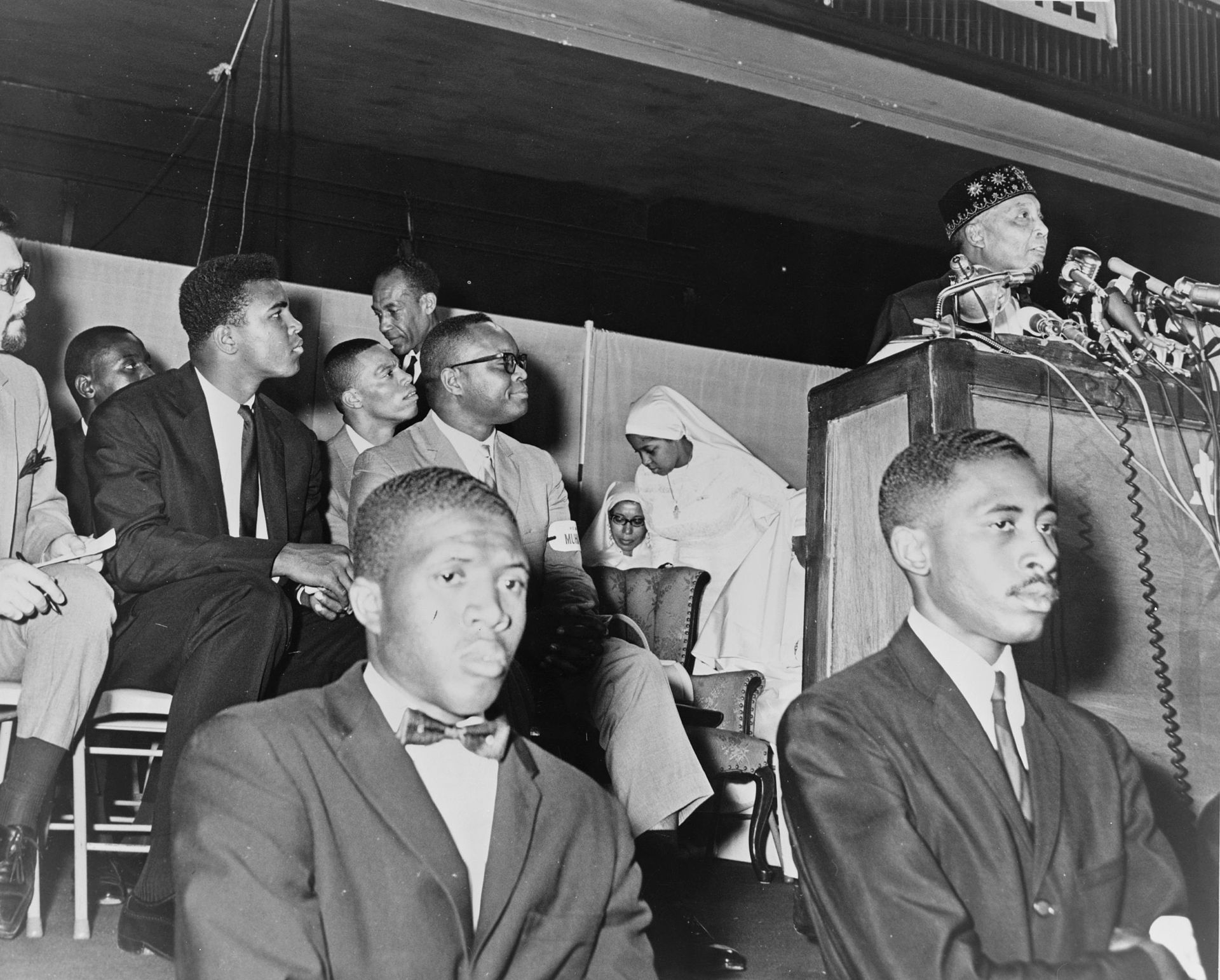 Advocacy and teachings while with Nation Elijah Muhammad is speaking at a podium and people are listening intently Muhammad Ali (second row, in dark suit) watches Elijah Muhammad speak, 1964 From his adoption of the Nation of Islam in 1952 until he broke with it in 1964, Malcolm X promoted the Nation's teachings. These included beliefs: That Black people are the original people of the world[101] That White people are "devils"[102] and That the demise of the White race is imminent.[103] Louis E. Lomax said that "those who don't understand biblical prophecy wrongly label him as a racist and as a hate teacher, or as being anti-White or as teaching Black Supremacy".[104] One of the goals of the civil rights movement was to end disenfranchisement of African Americans, but the Nation of Islam forbade its members from participating in voting and other aspects of the political process.[105] The NAACP and other civil rights organizations denounced him and the Nation of Islam as irresponsible extremists whose views did not represent the common interests of African Americans.[106][107] Malcolm X was equally critical of the civil rights movement.[108] He called Martin Luther King Jr. a "chump," and said other civil rights leaders were "stooges" of the White establishment. He was strongly against any kind of racial integration.[109][G] He called the 1963 March on Washington "the farce on Washington,"[112] and said he did not know why so many Black people were excited about a demonstration "run by Whites in front of a statue of a president who has been dead for a hundred years and who didn't like us when he was alive."[113] While the civil rights movement fought against racial segregation, Malcolm X advocated the complete separation of African Americans from Whites. He proposed that African Americans should return to Africa and that, in the interim, a separate country for Black people in America should be created.[114][115] He rejected the civil rights movement's strategy of nonviolence, arguing that Black people should defend and advance themselves "by any means necessary".[116] His speeches had a powerful effect on his audiences, who were generally African Americans in northern and western cities. Many of them—tired of being told to wait for freedom, justice, equality and respect[117]—felt that he articulated their complaints better than did the civil rights movement.[118][119] Antisemitism Malcolm X has been widely accused of being antisemitic.[120][121] His autobiography contains several "antisemitic charges and caricatures of Jews".[122] Alex Haley, the autobiography's co-author, had to rewrite some of the book to eliminate a number of negative statements about Jews in the manuscript.[123] Malcolm X believed that the fabricated antisemitic text The Protocols of the Elders of Zion was authentic and introduced it to NOI members, while accusing the Jewish people of "perfecting the modern evil" of neo-colonialism.[124][125] He helped change the Black community's image of The Holocaust, engaging in Holocaust trivialization and claiming that the Jews "brought it on themselves".[126] In 1961, Malcolm X spoke at a NOI rally alongside George Lincoln Rockwell, the head of the American Nazi Party. Rockwell saw overlap between Black nationalism and White supremacy.[127] According to historian Stephen H. Norwood, Malcolm X's negative statements about Jews continued even close to his death, referring to Jews as "bloodsucker[s]" in statements he made during the last months of his life.[128] Effect on Nation membership Malcolm X is widely regarded as the second most influential leader of the Nation of Islam after Elijah Muhammad.[129] He is largely credited with helping the group's dramatic increase in membership between the early 1950s and early 1960s—from around 1,200 to between 50,000 and 100,000 members, with up to 25,000 actively attending, according to estimates.[130][H][I] He inspired the boxer Muhammad Ali to join the Nation,[133] and the two became close.[134] In January 1964, Ali brought Malcolm X and his family to Miami to watch him train for his fight against Sonny Liston.[135] When Malcolm X left the Nation of Islam, he tried to convince Ali (who had just been renamed by Elijah Muhammad) to join him in converting to Sunni Islam, but Ali instead broke ties with him, later describing the break as one of his greatest regrets.[J] Malcolm X mentored and guided Louis X (later known as Louis Farrakhan), who eventually became the leader of the Nation of Islam.[137] Malcolm X also served as a mentor and confidant to Elijah Muhammad's son, Wallace D. Muhammad; the son told Malcolm X about his skepticism toward his father's "unorthodox approach" to Islam.[138] Wallace Muhammad was excommunicated from the Nation of Islam several times, although he was eventually re-admitted.[139] |
初期の聖職 1952年8月に仮釈放された後[58]、マルコムXはシカゴにイライジャ・ムハンマドを訪ねた[59]。1953年6月、彼はデトロイトにあるネーショ ンズ・テンプル・ナンバーワンの副牧師に任命された[60][60][C]。同年末、彼はボストンにテンプル・ナンバー11を設立し[62]、1954年 3月にはフィラデルフィアにテンプル・ナンバー12を拡大し[63]、その2ヵ月後にはハーレムにあるテンプル・ナンバー7の指導者に抜擢され[64]、 そこで急速に会員を拡大した[65]。 1953年、FBIは彼の監視を開始し、マルコムXの共産主義者との関係の可能性から、ネーション・オブ・イスラムにおける彼の急速な出世に注意を向けた[66]。 1955年、マルコムXはイスラム教国を代表して会員を勧誘し続け、成功を収めた。彼はマサチューセッツ州スプリングフィールド(13番)、コネチカット 州ハートフォード(14番)、アトランタ(15番)に寺院を設立した。毎月何百人ものアフリカ系アメリカ人がイスラム教国に入信していた[67]。 演説家としてのスキルに加えて、マルコムXは印象的な肉体的存在感を持っていた。ある作家は彼を「力強い体格」と評し[69]、また別の作家は「魅惑的なほどハンサムで......いつも完璧に身だしなみを整えていた」と評した[68]。 結婚と家族 1955年、ベティ・サンダースはマルコムXの講演会の後に出会い、ディナーパーティーで再会した。1956年、彼女はネーション・オブ・イスラムに入信 し、名前をベティXと改めた[70]。1対1のデートはネーションの教えに反するため、2人は何十人、何百人という他の人々と一緒に社交イベントで求愛 し、マルコムXはニューヨークの博物館や図書館への頻繁なグループ訪問に彼女を招待するようにした[71]。 1958年1月、マルコムXはデトロイトからの電話でプロポーズし、2日後に結婚した[72][73]: アッタラー(1958年生まれ、アラビア語で「神の贈り物」の意、おそらくフン族のアッティラにちなんで名づけられた)、[74][D][E] クビラー(1960年生まれ、クブライ・ハーンにちなんで名づけられた)、[78] イリヤサ(1962年生まれ、イライジャ・ムハンマドにちなんで名づけられた)、[79] ガミラ・ルムンバ(1964年生まれ、ガマル・アッバル・ムハンマドにちなんで名づけられた)、[78] ガミラ・ルムンバ(1964年生まれ、ガマル・アッバル・ムハンマドにちなんで名づけられた 1964年、ガマル・アブデル・ナセルとパトリス・ルムンバにちなんで命名)[80][81]、双子のマリカ(1965-2021年)[82]とマラク (1965年生まれ、いずれも父の死後に生まれ、父にちなんで命名)[83]。 ヒントン・ジョンソン事件 1957年、イスラム教国メンバーのヒントン・ジョンソン[F]がニューヨーク市警の警官2人に殴打された事件がきっかけで、アメリカ国民は初めてマルコ ムXの存在を知った[86][87]。 4月26日、ジョンソンと他の2人の通行人(イスラム教国メンバーでもあった)は、警官がナイトスティックでアフリカ系アメリカ人の男性を殴っているのを 目撃した。 [86]彼らが「ここはアラバマじゃない・・・ニューヨークだ!」と叫びながら仲裁に入ろうとすると[87]、警官の一人がジョンソンに殴りかかり、脳挫 傷と硬膜下出血を起こすほどひどく殴った。4人のアフリカ系アメリカ人男性は全員逮捕された[86]。 目撃者によって警告されたマルコムXとイスラム教徒の小集団は警察署に行き、ジョンソンに会うことを要求した[86]。警察は当初、イスラム教徒が拘束さ れていることを否定していたが、群衆が500人ほどになると、マルコムXがジョンソンと話すことを許可した[88]。その後、マルコムXはジョンソンを ハーレム病院に運ぶための救急車の手配を主張した[89]。 ジョンソンの怪我は手当てされ、彼が警察署に戻される頃には、4000人ほどの人々が外に集まっていた[88]。警察署内では、マルコムXと弁護士がイス ラム教徒2人の保釈手続きを行っていた。ジョンソンは保釈されず、警察は翌日の罪状認否まで病院に戻れないと言った[89]。事態が行き詰まったと考えた マルコムXは、警察署の外に出て群衆に手信号を送った。ネーションメンバーは黙って立ち去り、その後、他の群衆も散っていった[89]。 ある警察官は『ニューヨーク・アムステルダム・ニュース』紙にこう語った: 「ニューヨーク市警は1ヵ月以内にマルコムXを監視下に置くよう手配し、彼が住んでいた他の都市や服役していた刑務所の当局にも問い合わせを行った [91]。 大陪審はジョンソンを殴った警官を起訴することを拒否した。10月、マルコムXは警視総監に怒りの電報を打った。間もなく警察署は、「イスラム国」に潜入 する覆面警官を配属した[92]。 ますます目立つようになる 1950年代後半になると、マルコムXはマルコム・シャバズまたはエル・ハジ・マリク・エル・シャバズ(「巡礼者マルコム・ザ・パトリアーク」)という新しい名前を使っていた[93][94][95]。 1960年9月、ニューヨークで開催された国連総会で、マルコムXはいくつかのアフリカ諸国の公式行事に招待された。彼はエジプトのガマル・アブデル・ナ セル、ギニアのアーメッド・セクー・トゥーレ、ザンビア・アフリカ民族会議のケネス・カウンダに会った[98]。フィデル・カストロも総会に出席し、マル コムXはハーレム・コミュニティのリーダーたちによる歓迎委員会の一員として彼と公に会った[99]。  ネーション在籍中の主張と教え イライジャ・ムハンマドは演壇で演説し、人々は熱心に耳を傾けている。 モハメド・アリ(2列目、ダークスーツ)がイライジャ・ムハンマドの演説を見守る(1964年 マルコムXは1952年にイスラム教国に入信してから1964年に脱退するまで、イスラム教国の教えを広めた。その中には次のような信念が含まれていた: 黒人は世界の原住民である[101]。 白人は「悪魔」である[102]。 白人の滅亡は間近に迫っている[103]。 ルイス・E・ローマックスは、「聖書の予言を理解していない人々は、彼を人種差別主義者、ヘイト教師、反白人、黒人至上主義を教えているといった間違った レッテルを貼っている」と述べている[104]。公民権運動の目標のひとつは、アフリカ系アメリカ人の権利剥奪をなくすことであったが、ネーション・オ ブ・イスラムはそのメンバーが投票やその他の政治過程に参加することを禁じていた。 [105]NAACPと他の公民権団体は、彼とイスラム国を、アフリカ系アメリカ人の共通の利益を代表しない無責任な過激派として非難した[106] [107]。 マルコムXは公民権運動に対しても同様に批判的であった[108]。 彼はマーティン・ルーサー・キング・ジュニアを「まぬけ」と呼び、他の公民権運動の指導者たちは白人体制の「手先」であると言った。彼はあらゆる人種統合 に強く反対していた[109][G]。 1963年のワシントン大行進を「ワシントンの茶番劇」と呼び[112]、「100年前に死んでいて、生きていたときに我々を嫌っていた大統領の銅像の前 で白人が行うデモ」になぜ多くの黒人が興奮するのかわからないと言った[113]。 公民権運動が人種隔離と闘う一方で、マルコムXはアフリカ系アメリカ人と白人の完全な分離を提唱した。彼は、アフリカ系アメリカ人はアフリカに帰るべきで あり、その間にアメリカに黒人のための独立した国を作るべきだと提案した[114][115]。 彼は公民権運動の非暴力という戦略を否定し、黒人は「必要なあらゆる手段によって」自分たちを守り、前進すべきだと主張した[116]。 彼の演説は、北部や西部の都市に住むアフリカ系アメリカ人を中心とした聴衆に強い影響を与えた。彼らの多くは、自由、正義、平等、尊敬[117]を待つよ うに言われることにうんざりしており、彼が公民権運動よりも自分たちの不満を明確に表現していると感じていた[118][119]。 反ユダヤ主義 マルコムXは反ユダヤ主義者であると広く非難されている[120][121]。 自伝の共著者であるアレックス・ヘイリー(Alex Haley)は、原稿中のユダヤ人についての否定的な記述を削除するために、本の一部を書き直さなければならなかった。 [123]マルコムXは、捏造された反ユダヤ主義的なテキスト『シオン長老の議定書』が本物であると信じ、それをNOIのメンバーに紹介する一方で、ユダ ヤ人が新植民地主義という「現代の悪を完成させた」と非難した[124][125]。 ホロコーストの矮小化に関与し、ユダヤ人が「自ら招いた」と主張することで、ホロコーストに対する黒人社会のイメージを変える手助けをした[126]。 1961年、マルコムXはNOIの集会でアメリカ・ナチ党首のジョージ・リンカーン・ロックウェルとともに演説した。ロックウェルは黒人ナショナリズムと 白人至上主義との間に重なるものを見出していた[127]。歴史家スティーヴン・H・ノーウッドによれば、マルコムXのユダヤ人に対する否定的な発言は死 の間際まで続き、晩年の数ヶ月の発言ではユダヤ人を「吸血者(bloodsucker[s])」と呼んでいた[128]。 ネーション・メンバーシップへの影響 マルコムXは、イライジャ・ムハンマドの次に影響力のあるネーション・オブ・イスラムの指導者であると広くみなされている[129]。 彼は、1950年代初頭から1960年代初頭にかけて、ネーション・オブ・イスラムの会員数が劇的に増加したことに大きく貢献しているとされている。 1964年1月、アリはマルコムXとその家族をマイアミに連れてきて、ソニー・リストンとの試合の練習を見学させた[135]。 マルコムXがイスラム教国から脱退したとき、彼はアリ(イライジャ・ムハンマドによって改名されたばかりであった)にイスラム教スンニ派への改宗に加わる よう説得しようとしたが、アリはその代わりに彼との関係を断ち、後にこの断絶を最大の後悔のひとつと述べている[J]。 マルコムXはルイX(後にルイ・ファラカンとして知られる)を指導し、指導した。マルコムXはまた、イライジャ・ムハンマドの息子であるウォレス・D・ム ハンマドの指導者であり、親友でもあった。ウォレス・ムハンマドはマルコムXに、父のイスラム教に対する「異端的なアプローチ」に対する懐疑心を語った [138]。 |
| Disillusionment and departure During 1962 and 1963, events caused Malcolm X to reassess his relationship with the Nation of Islam, and particularly its leader, Elijah Muhammad. Lack of Nation of Islam response to LAPD violence In late 1961, there were violent confrontations between the Nation of Islam members and police in South Central Los Angeles, and numerous Muslims were arrested. They were acquitted, but tensions had been raised. Just after midnight on April 27, 1962, two LAPD officers, unprovoked, shoved and beat several Muslims outside Temple Number 27. A large crowd of angry Muslims emerged from the mosque and the officers attempted to intimidate them.[140][141] One officer was disarmed; his partner was shot in the elbow by a third officer. More than 70 backup officers arrived who then raided the mosque and randomly beat Nation of Islam members. Police officers shot seven Muslims, including William X Rogers, who was hit in the back and paralyzed for life, and Ronald Stokes, a Korean War veteran, who was shot from behind while raising his hands over his head to surrender, killing him.[140][141] A number of Muslims were indicted after the event, but no charges were laid against the police. The coroner ruled that Stokes's killing was justified. To Malcolm X, the desecration of the mosque and the associated violence demanded action, and he used what Louis X (later Louis Farrakhan) later called his "gangsterlike past" to rally the more hardened of the Nation of Islam members to take violent revenge against the police.[140][141] Malcolm X sought Elijah Muhammad's approval which was denied, stunning Malcolm X. Malcolm X was again blocked by Elijah Muhammad when he spoke of the Nation of Islam starting to work with civil rights organizations, local Black politicians, and religious groups. Louis X saw this as an important turning point in the deteriorating relationship between Malcolm X and Muhammad.[140][141] Sexual misbehavior by Elijah Muhammad Rumors were circulating that Muhammad was conducting extramarital affairs with young Nation secretaries—which would constitute a serious violation of Nation teachings. After first discounting the rumors, Malcolm X came to believe them after he spoke with Muhammad's son Wallace and with the girls making the accusations. Muhammad confirmed the rumors in 1963,[when?] attempting to justify his behavior by referring to precedents set by Biblical prophets.[142] Over a series of national TV interviews between 1964 and 1965, Malcolm X provided testimony of his investigation, corroboration, and confirmation by Elijah Muhammed himself of multiple counts of child rape. During this investigation, he learned that seven of the eight girls had become pregnant as a result of this. He also revealed an assassination attempt made on his life, through a discovered explosive device in his car, as well as the death threats he was receiving, in response to his exposure of Elijah Muhammad.[143][better source needed] Remarks on Kennedy assassination On December 1, 1963, when asked to comment on the assassination of John F. Kennedy, Malcolm X said that it was a case of "chickens coming home to roost." He added that "chickens coming home to roost never did make me sad; they've always made me glad."[144] Likewise, according to The New York Times:[144] [I]n further criticism of Mr. Kennedy, the Muslim leader cited the murders of Patrice Lumumba, Congo leader, of Medgar Evers, civil rights leader, and of the Negro girls bombed earlier this year in a Birmingham church. These, he said, were instances of other "chickens coming home to roost". The remarks prompted widespread public outcry. The Nation of Islam, which had sent a message of condolence to the Kennedy family and ordered its ministers not to comment on the assassination, publicly censured their former shining star.[145] Malcolm X retained his post and rank as minister but was prohibited from public speaking for 90 days.[146] Media attention to Malcolm X over Muhammad Malcolm X had by now become a media favorite, and some Nation members believed he was a threat to Muhammad's leadership. Publishers had shown interest in Malcolm X's autobiography, and when Louis Lomax wrote his 1963 book about the Nation, When the Word Is Given, he used a photograph of Malcolm X on the cover. He also reproduced five of his speeches but featured only one of Muhammad's, which greatly upset Muhammad and made him envious.[147] Departure from Nation of Islam On March 8, 1964, Malcolm X publicly announced his break from the Nation of Islam. Though still a Muslim, he felt that the Nation had "gone as far as it can" because of its rigid teachings. He said he was planning to organize a Black nationalist organization to "heighten the political consciousness" of African Americans. He also expressed a desire to work with other civil rights leaders, saying that Elijah Muhammad had prevented him from doing so in the past.[148] |
幻滅と離脱 1962年から1963年にかけて、マルコムXはイスラム教国、特にその指導者であるイライジャ・ムハンマドとの関係を見直すきっかけとなる出来事があった。 ロス市警の暴力に対するイスラム協会の対応の欠如 1961年後半、ロサンゼルスのサウスセントラルで、イスラム教ネーション・オブ・イスラムのメンバーと警察との間で暴力的な対立が起こり、多数のイスラ ム教徒が逮捕された。彼らは無罪となったが、緊張は高まっていた。1962年4月27日の真夜中過ぎ、ロサンゼルス市警の警官2人がテンプル・ナンバー 27の外で、無抵抗のイスラム教徒数人を突き飛ばし、殴打した。怒ったイスラム教徒の大群衆がモスクから現れ、警官たちは彼らを威嚇しようとした [140][141]。 警官1人が武装を解かれ、彼のパートナーは3人目の警官によって肘を撃たれた。その後、70人以上の応援の警官が到着し、モスクに突入し、無差別に「イス ラム国」のメンバーを殴打した。警察官は、背中を撃たれて下半身不随になったウィリアム・X・ロジャースや、降伏のために両手を頭の上に上げているところ を背後から撃たれて死亡した朝鮮戦争帰還兵のロナルド・ストークスを含む7人のイスラム教徒を射殺した[140][141]。 事件の後、多くのイスラム教徒が起訴されたが、警察に対する告発はなかった。検視官はストークスの殺害は正当であると裁定した。マルコムXにとって、モス クの冒涜とそれに関連する暴力は行動を要求するものであり、彼は後にルイX(後のルイ・ファラカン)が言うところの「ギャングのような過去」を利用して、 警察に対して暴力的な復讐をするために、より固いイスラム教国メンバーを結集させた[140][141]。 マルコムXはイライジャ・ムハンマドの承認を求めたが拒否され、マルコムXは驚愕した。マルコムXは、イスラム教国が公民権団体、地元の黒人政治家、宗教 団体と協力し始めることを話すと、再びイライジャ・ムハンマドに妨害された。ルイXはこれをマルコムXとムハンマドの関係悪化の重要な転機と見なした [140][141]。 イライジャ・ムハンマドによる性的不品行 モハメッドがネーションの若い秘書と不倫関係にあるという噂が流れた。最初はその噂を否定していたマルコムXだったが、ムハンマドの息子ウォレスや告発者 の少女たちと話をするうちに、その噂を信じるようになった。ムハンマドは1963年にその噂を認め、[いつ?]聖書の預言者が定めた前例を引き合いに出し て自分の行動を正当化しようとした[142]。 マルコムXは、1964年から1965年にかけての一連の全国的なテレビのインタビューにおいて、イライジャ・ムハメッド自身による複数の児童強姦の調 査、裏付け、確認についての証言を行った。この調査中、彼は8人の少女のうち7人がこの結果妊娠したことを知った。また、イライジャ・ムハンマドを暴露し たことで、彼の車から爆発物が発見され、暗殺未遂に遭ったことや、殺害予告を受けていたことも明らかにした[143][要出典]。 ケネディ暗殺に関する発言 1963年12月1日、ジョン・F・ケネディの暗殺についてコメントを求められたマルコムXは、「鶏がねぐらに帰ってきた」と語った。彼は、「鶏がねぐら に帰ってくることは、決して私を悲しませることはなく、いつも私を喜ばせてくれた」と付け加えた[144]。同様に、『ニューヨーク・タイムズ』紙によれ ば、次のように述べた[144]。 [ケネディ氏へのさらなる批判として、イスラム教指導者はコンゴの指導者パトリス・ルムンバ、公民権運動の指導者メドガー・エヴァーズ、そして今年初めにバーミンガムの教会で爆破された黒人の少女たちの殺害を挙げた。これらは「鶏がねぐらに帰ってきた」例であると述べた。 この発言は広く世論の反発を招いた。ケネディ一家に哀悼のメッセージを送り、暗殺についてコメントしないよう閣僚たちに命じていたネーションズ・オブ・イ スラームは、かつての輝けるスターを公に非難した[145]。マルコムXは閣僚としての地位とポストを維持したが、90日間公の場で発言することを禁じら れた[146]。 ムハンマドをめぐるマルコムXへのメディアの注目 マルコムXは今やメディアの人気者となっており、一部のネーションメンバーは彼がムハンマドの指導力を脅かす存在だと考えていた。出版社はマルコムXの自 伝に興味を示し、ルイス・ローマックスが1963年にネーションについての本『When the Word Is Given』を書いたとき、表紙にマルコムXの写真を使った。彼はまた、彼の5つの演説を再現したが、ムハンマドの演説は1つしか取り上げなかったため、 ムハンマドは大いに動揺し、嫉妬した[147]。 ネーション・オブ・イスラムからの脱退 1964年3月8日、マルコムXはネーション・オブ・イスラムからの離脱を公に発表した。まだイスラム教徒ではあったが、彼はその厳格な教えのために、 ネーションが「できるところまで行ってしまった」と感じていた。彼は、アフリカ系アメリカ人の「政治的意識を高める」ために黒人民族主義組織を組織するつ もりだと語った。彼はまた、他の公民権運動の指導者たちとも協力したいと表明し、イライジャ・ムハンマドが過去にそれを妨げていたと語った[148]。 |
Activity after leaving Nation of Islam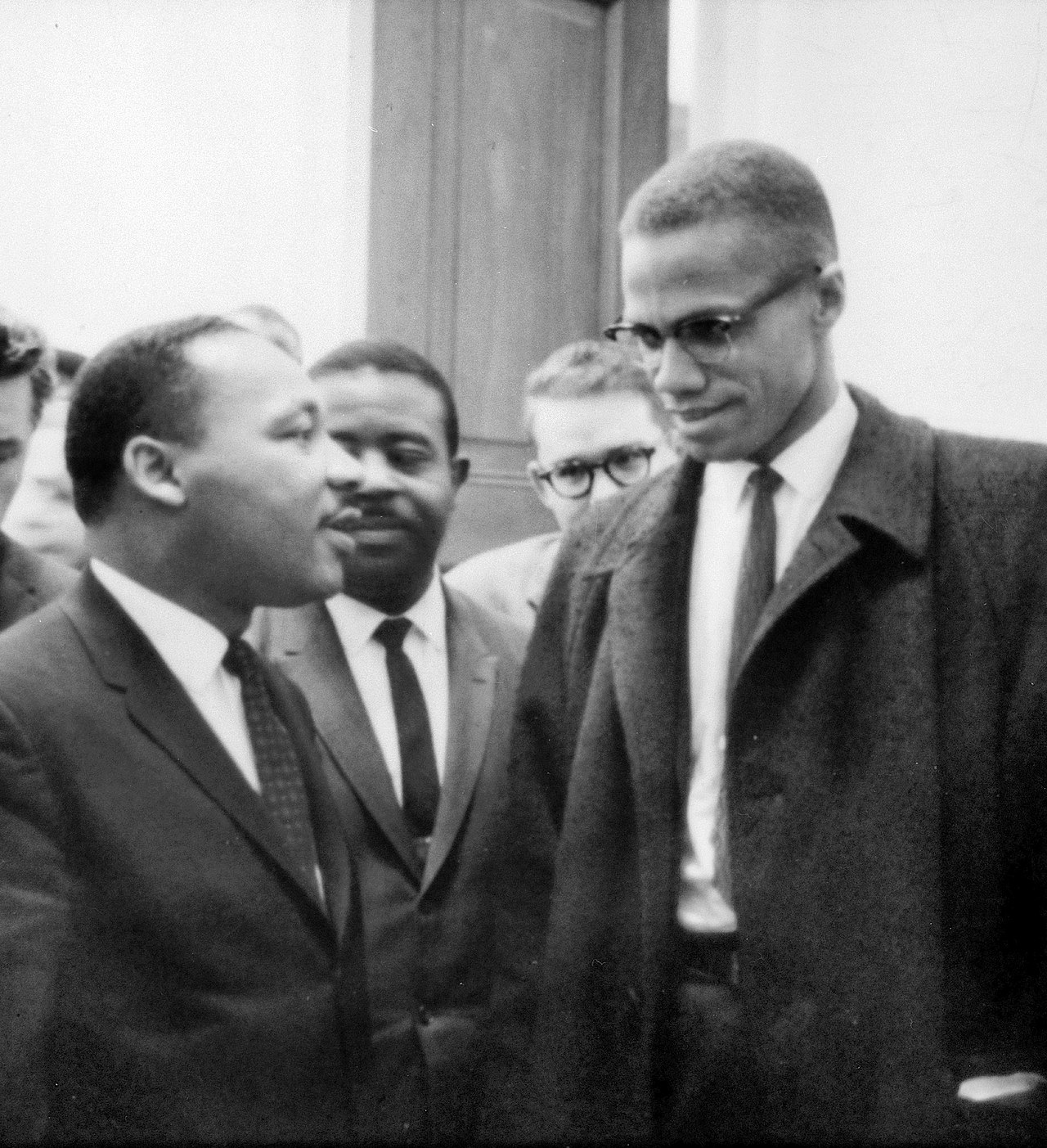 Malcolm X's only meeting with Martin Luther King Jr., March 26, 1964, during the Senate debates regarding the (eventual) Civil Rights Act of 1964.[149] After leaving the Nation of Islam, Malcolm X founded Muslim Mosque, Inc. (MMI), a religious organization,[150][151] and the Organization of Afro-American Unity (OAAU), a secular group that advocated Pan-Africanism.[152][153] On March 26, 1964, he briefly met Martin Luther King Jr. for the first and only time—and only long enough for photographs to be taken—in Washington, D.C., as both men attended the Senate's debate on the Civil Rights bill at the U.S. Capitol building.[K][L] In April, Malcolm X gave a speech titled "The Ballot or the Bullet", in which he advised African Americans to exercise their right to vote wisely but cautioned that if the government continued to prevent African Americans from attaining full equality, it might be necessary for them to take up arms.[156][157] In the weeks after he left the Nation of Islam, several Sunni Muslims encouraged Malcolm X to learn about their faith. He soon converted to the Sunni faith.[158][159] Pilgrimage to Mecca In April 1964, with financial help from his half-sister Ella Little-Collins, Malcolm X flew to Jeddah, Saudi Arabia, as the start of his Hajj, the pilgrimage to Mecca obligatory for every Muslim who is able to do so. He was delayed in Jeddah when his U.S. citizenship and inability to speak Arabic caused his status as a Muslim to be questioned.[160][161] He had received Abdul Rahman Hassan Azzam's book The Eternal Message of Muhammad with his visa approval, and he contacted the author. Azzam's son arranged for his release and lent him his personal hotel suite. The next morning Malcolm X learned that Prince Faisal had designated him as a state guest.[162] Several days later, after completing the Hajj rituals, Malcolm X had an audience with the prince.[163] Malcolm X later said that seeing Muslims of "all colors, from blue-eyed blonds to Black-skinned Africans," interacting as equals led him to see Islam as a means by which racial problems could be overcome.[164] Visit to Cairo 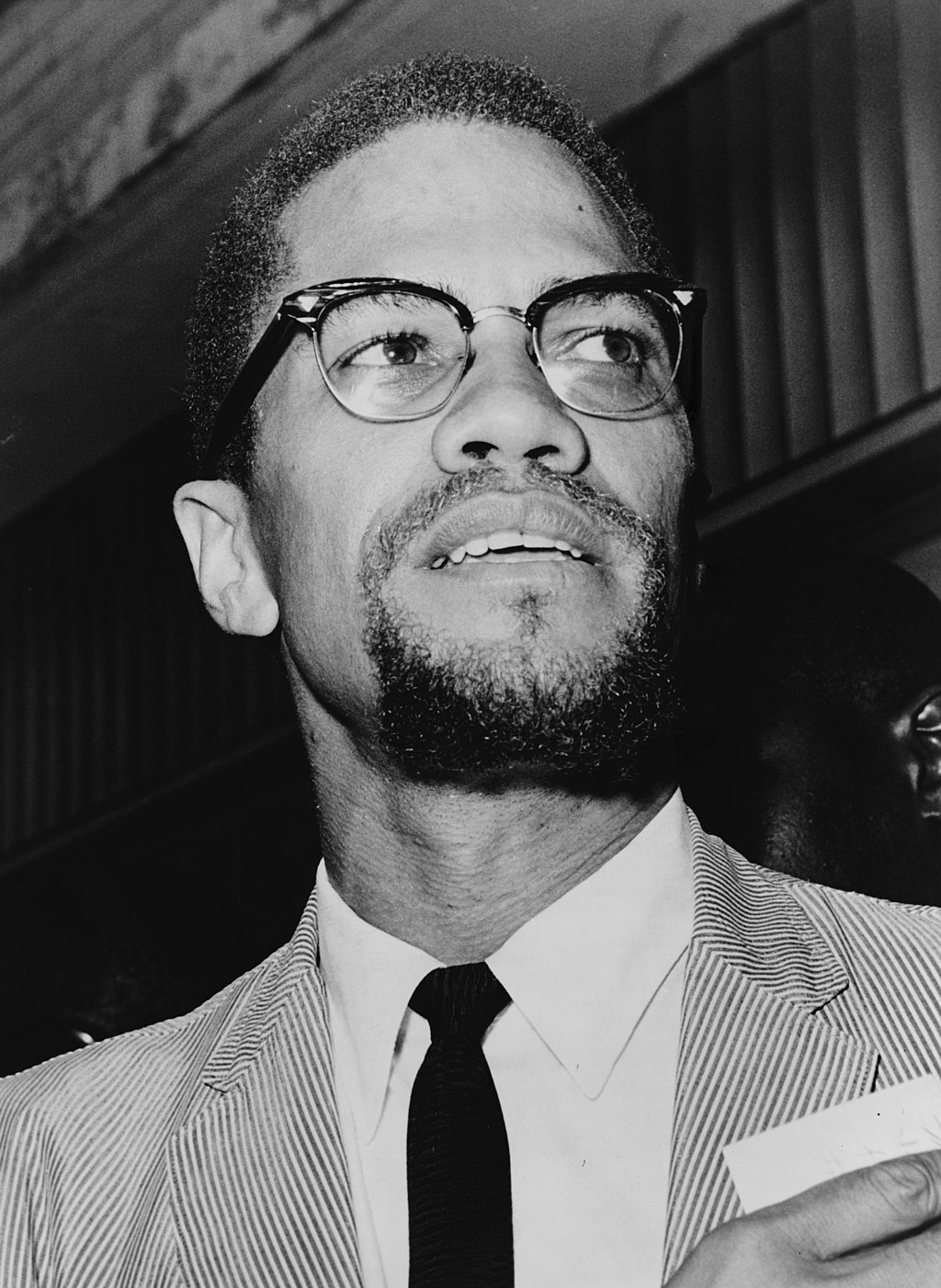 Malcolm X in 1964 Malcolm X, after his 1964 pilgrimage to Mecca Malcolm X had already visited the United Arab Republic (a short-lived political union between Egypt and Syria), Sudan, Nigeria, and Ghana in 1959 to make arrangements for a tour of Africa by Elijah Muhammad.[165] After his pilgrimage to Mecca in April 1964, he visited Africa a second time. He returned to the United States in late May[166] and flew to Africa again in July.[167] During these visits he met officials, gave interviews, and spoke on radio and television in Egypt, Ethiopia, Tanganyika, Nigeria, Ghana, Guinea, Sudan, Senegal, Liberia, Algeria and Morocco.[168] In Cairo, he attended the second meeting of the Organization of African Unity as a representative of the OAAU.[169] By the end of this third visit, he had met with essentially all of Africa's prominent leaders;[170] Kwame Nkrumah of Ghana, Gamal Abdel Nasser of Egypt, and Ahmed Ben Bella of Algeria had all invited Malcolm X to serve in their governments.[170] After he spoke at the University of Ibadan, the Nigerian Muslim Students Association bestowed on him the honorary Yoruba name Omowale ('the son who has come home').[171] He later called this his most treasured honor.[172] Malcolm especially hated Moïse Tshombe of the Congo as an "Uncle Tom" figure. In a 1964 speech in New York, he called Tshombe "the worse African ever born" and "the man who in cold blood, cold blood, committed an international crime-murdered Patrice Lumumba".[173] Tshombe's decision in 1964 to hire White mercenaries to put down the Simba rebellion greatly offended Malcolm, who accused the mercenaries of committing war crimes against the Congolese.[174] France and United Kingdom On November 23, 1964, on his way home from Africa, Malcolm X stopped in Paris, where he spoke in the Salle de la Mutualité.[175][176] After his return to the United States, he accused the United States of imperialism in the Congo by supporting Tshombe and "his hired killers" as he called the White mercenaries.[174] X accused Tshombe and the American president Lyndon B. Johnson of "...sleeping together. When I say sleeping together, I don't mean that literally. But beyond that, they're in the same bed. Johnson is paying the salaries, paying the government, propping up Tshombe's government, this murderer".[174] X expressed much anger about Operation Dragon Rouge, where the United States Air Force dropped in Belgian paratroopers into the city of Stanleyville, modern Kisangani, to rescue the White Belgian hostages from the Simbas.[174] Malcolm X maintained that there was a double standard when it came to White and Black lives, noting it was an international emergency when the lives of Whites were in danger, making Dragon Rouge necessary, but that nothing was done to stop the abuses of the Congolese at the hands of "Tshombe's hired killers".[177] X charged that the "Congolese have been massacred by White people for years and years" and that "the chickens have home to roast".[178] A week later, on November 30, Malcolm X flew to the United Kingdom. On December 3 he took part in a debate at the Oxford Union Society. The motion was taken from a statement made earlier that year by U.S. presidential candidate Barry Goldwater: "Extremism in the Defense of Liberty is No Vice; Moderation in the Pursuit of Justice is No Virtue".[179] Malcolm X argued for the affirmative, and interest in the debate was so high that it was televised nationally by the BBC.[180][181] In his address at Oxford, Malcolm rejected the label of "Black Muslim" and instead focused on being a Muslim who happened to be Black, which reflected his conversion to Sunni Islam.[182] Malcolm only mentioned his religion twice during his Oxford speech, which was part of his effort to defuse his image as an "angry Black Muslim extremist", which he had long hated.[182] During the debate at Oxford, he criticized the way the Anglo-American press portrayed the Congo crisis, noting the Simbas were portrayed as primitive cannibalistic "savages" who engaged in every form of depravity imaginable while Tshombe and the White mercenaries were portrayed in a very favorable light with almost no mention of any atrocities on their part.[177] Malcolm X charged that the Cuban émigré pilots hired by the CIA to serve as Tshombe's air force indiscriminately bombed Congolese villages and towns, killing women and children, but this was almost never mentioned in the media while the newspapers featured long accounts of the Simbas "raping White women, molesting nuns".[183] Likewise, he felt the term mercenary was inappropriate, preferring the term "hired killer" and that Tshombe should not be described as a premier as he preferred the term "cold-blooded murderer" to describe him.[183] Malcolm X stated that what he regarded as the extremism of the Tshombe government was "never referred to as extremism because it is endorsed by the West, it is financed by America, it's made respectable by America, and that kind of extremism is never labelled as extremism".[184] Malcolm X argued this extremism was not morally acceptable "since it's not extremism in defense of liberty".[185] Many in the audience at Oxford were angered by Malcolm X's thesis and his support for the Simbas who had committed atrocities with one asking, "What sort of extremism would you consider the killing of missionaries?".[185] In response, Malcolm X answered "It is an act of war. I'd call it the same kind of extremism that happened when England dropped bombs on German cities and Germans dropped bombs on English cities".[185] On February 5, 1965, Malcolm X flew to the United Kingdom again,[186] and on February 8 he addressed the first meeting of the Council of African Organizations in London.[187] The next day he tried to return to France, but was refused entry.[188] On February 12, he visited Smethwick, near Birmingham, where the Conservative Party had won the parliamentary seat in the 1964 general election. The town had become a byword for racial division after the successful candidate, Peter Griffiths, was accused of using the slogan, "If you want a nigger for a neighbour, vote Liberal or Labour." In Smethwick, Malcolm X compared the treatment of ethnic minority residents with the treatment of Jews under Hitler, saying: "I would not wait for the fascist element in Smethwick to erect gas ovens."[189][190] Return to United States After returning to the U.S., Malcolm X addressed a wide variety of audiences. He spoke regularly at meetings held by MMI and the OAAU, and was one of the most sought-after speakers on college campuses.[191] One of his top aides later wrote that he "welcomed every opportunity to speak to college students."[192] He also addressed public meetings of the Socialist Workers Party, speaking at their Militant Labor Forum.[193] He was interviewed on the subjects of segregation and the Nation of Islam by Robert Penn Warren for Warren's 1965 book Who Speaks for the Negro?[194] Death threats and intimidation from Nation of Islam 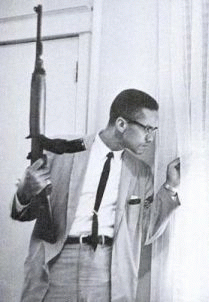 Malcolm X, carrying a rifle, peers out the window Malcolm X guards his family after Nation of Islam threats in an iconic Ebony magazine photo. Throughout 1964, as his conflict with the Nation of Islam intensified, Malcolm X was repeatedly threatened.[195] In February, a leader of Temple Number Seven ordered the bombing of Malcolm X's car.[196] In March, Muhammad told Boston minister Louis X (later known as Louis Farrakhan) that "hypocrites like Malcolm should have their heads cut off";[197] the April 10 edition of Muhammad Speaks featured a cartoon depicting Malcolm X's bouncing, severed head.[198][199] On June 8, FBI surveillance recorded a telephone call in which Betty Shabazz was told that her husband was "as good as dead."[200] Four days later, an FBI informant received a tip that "Malcolm X is going to be bumped off."[201] That same month, the Nation sued to reclaim Malcolm X's residence in East Elmhurst, Queens, New York. His family was ordered to vacate[202] but on February 14, 1965—the night before a hearing on postponing the eviction—the house was destroyed by fire.[203] On July 9, Muhammad aide John Ali (suspected of being an undercover FBI agent)[204] referred to Malcolm X by saying, "Anyone who opposes the Honorable Elijah Muhammad puts their life in jeopardy."[205] In the December 4 issue of Muhammad Speaks, Louis X wrote that "such a man as Malcolm is worthy of death."[206] The September 1964 issue of Ebony dramatized Malcolm X's defiance of these threats by publishing a photograph of him holding an M1 carbine while peering out of a window.[207][208] |
ネーション・オブ・イスラム脱退後の活動 マルコムXとマーティン・ルーサー・キング・ジュニアとの唯一の面会(1964年3月26日、1964年公民権法(最終的な)に関する上院での討論の最中)[149]。 1964年3月26日、マルコムXはワシントンD.C.でマーティン・ルーサー・キング・ジュニアに初めて、そして写真が撮られるのに十分な時間だけ会った、 二人は連邦議会議事堂で行われた公民権法案に関する上院の討論会に出席した[K][L]。 4月、マルコムXは「The Ballot or the Bullet(投票か、銃弾か)」と題したスピーチを行い、アフリカ系アメリカ人に投票権を賢く行使するよう忠告したが、政府がアフリカ系アメリカ人の完 全な平等の達成を妨げ続けるのであれば、彼らが武器を取ることが必要になるかもしれないと警告した[156][157]。 彼がネーション・オブ・イスラムを脱退した数週間後、何人かのスンニ派のイスラム教徒がマルコムXに彼らの信仰について学ぶように勧めた。彼はすぐにスンニ派に改宗した[158][159]。 メッカへの巡礼 1964年4月、マルコムXは異母姉のエラ・リトル=コリンズから資金援助を受け、サウジアラビアのジッダへ飛んだ。ジェッダでは、彼のアメリカ市民権やアラビア語が話せないことから、ムスリムとしてのステータスを疑われ、遅れをとった[160][161]。 彼はビザの承認と共にアブドゥル・ラーマン・ハッサン・アッザームの著書『ムハンマドの永遠のメッセージ』を受け取っており、著者に連絡を取った。アッ ザームの息子は彼の釈放を手配し、彼の個人的なホテルのスイートを貸した。翌朝、マルコムXはファイサル王子が彼を国賓として指名したことを知った [162]。数日後、ハッジの儀式を終えたマルコムXは王子に謁見した[163]。 マルコムXは後に、「青い目のブロンドから黒い肌のアフリカ人まで、あらゆる色」のイスラム教徒が対等に交流しているのを見て、イスラム教が人種問題を克服する手段であると考えるようになったと語っている[164]。 カイロ訪問  1964年のマルコムX 1964年のメッカ巡礼を終えたマルコムX マルコムXは、イライジャ・ムハンマドによるアフリカツアーの手配のため、1959年にアラブ連合共和国(エジプトとシリアの間の短期間の政治同盟)、 スーダン、ナイジェリア、ガーナをすでに訪問していた[165]。1964年4月のメッカ巡礼の後、彼は2度目のアフリカ訪問を行った。これらの訪問の 間、彼はエジプト、エチオピア、タンガニーカ、ナイジェリア、ガーナ、ギニア、スーダン、セネガル、リベリア、アルジェリア、モロッコで高官に会い、イン タビューを受け、ラジオやテレビで話した[168]。 カイロでは、OAAUの代表としてアフリカ統一機構の第2回会合に出席した[169]。この3回目の訪問が終わるまでに、彼はアフリカの著名な指導者たち 全員と基本的に会っていた[170]。ガーナのクワメ・クルマ、エジプトのガマル・アブデル・ナセル、アルジェリアのアーメド・ベン・ベラは皆、マルコム Xを自国の政府に招聘していた。 [170]イバダン大学で講演した後、ナイジェリアのムスリム学生協会は彼にオモワレ(「帰ってきた息子」)というヨルバ語の名誉名を与えた[171]。 彼は後にこれを最も大切な名誉と呼んだ[172]。 マルコムは特にコンゴのモイセ・シャンベを「アンクル・トム」のような人物として嫌っていた。1964年のニューヨークでの演説で、彼はツォンベを「生ま れてきた中で最も悪いアフリカ人」、「冷血に、冷血に国際犯罪を犯し、パトリス・ルムンバを殺害した男」と呼んだ[173]。1964年にツォンベがシン バの反乱を鎮圧するために白人の傭兵を雇うという決定を下したことで、マルコムは大いに腹を立て、傭兵がコンゴ人に対して戦争犯罪を犯したと非難した [174]。 フランスとイギリス 1964年11月23日、アフリカからの帰途、マルコムXはパリに立ち寄り、サル・ド・ラ・ミュチュアリテで演説した[175][176]。アメリカに 戻った後、彼はツォンベと彼が白人傭兵と呼ぶ「彼の雇った殺し屋」を支援することによって、コンゴにおけるアメリカの帝国主義を非難した[174]。一緒 に寝ると言っても、文字通りの意味ではない。しかし、それ以上に、彼らは同じベッドにいる。ジョンソンは給料を払い、政府に金を払い、この殺人者である ツォンベの政府を支えている」[174]。 Xは、ドラゴン・ルージュ作戦について多くの怒りを表明した。ドラゴン・ルージュ作戦とは、アメリカ空軍がシンバからベルギー白人の人質を救出するため に、ベルギーの空挺部隊をスタンレーヴィル(現在のキサンガニ)の街に降下させた作戦である。 [マルコムXは、白人と黒人の命に関しては二重基準があると主張し、白人の命が危険にさらされているときは国際的な緊急事態であり、ドラゴン・ルージュが 必要であると指摘したが、「ツォンベの雇った殺し屋」の手によるコンゴ人の虐待を止めることは何もなされなかった[177]。 Xは、「コンゴ人は何年も何年も白人によって虐殺されてきた」「鶏は家で焼くしかない」と告発した[178]。 一週間後の11月30日、マルコムXはイギリスに飛んだ。12月3日、彼はオックスフォード・ユニオン協会での討論会に参加した。この動議は、その年の初 めにアメリカ大統領候補バリー・ゴールドウォーターが行った声明から取られたものであった: 「自由を守るための過激主義は悪徳ではなく、正義を追求するための中庸は美徳ではない」[179]。マルコムXは肯定派を主張し、この討論会への関心は非 常に高く、BBCによって全国放送された[180][181]。 オックスフォードでの演説でマルコムは「ブラック・ムスリム」というレッテルを拒否し、代わりにたまたま黒人であったムスリムであることに焦点を当てた。 [182]オックスフォードでの討論の中で、彼は英米のマスコミがコンゴ危機を描く方法を批判し、シンバ族が原始的な人肉食の「野蛮人」として描かれ、想 像しうるあらゆる形態の堕落に従事している一方で、ツォンベと白人の傭兵は非常に好意的に描かれ、彼らの残虐行為についてはほとんど言及されていないこと を指摘した[177]。 マルコムXは、ツォンベの空軍としてCIAに雇われたキューバ移民パイロットがコンゴの村や町を無差別に爆撃し、女性や子供を殺害したことを告発したが、 このことはメディアではほとんど触れられなかった。 [183]同様に、彼は傭兵という言葉は不適切で、「雇われ殺人者」という言葉を好み、ツォンベを「冷血な殺人者」という言葉で表現することを好んだの で、ツォンベを首相と表現すべきではないと感じていた。 [183]マルコムXは、ツォンベ政府の過激主義とみなすものが「過激主義と呼ばれることはない。なぜなら、それは西側諸国によって支持され、アメリカに よって資金提供され、アメリカによって立派にされ、そのような過激主義は決して過激主義としてレッテルを貼られることはないからだ」と述べた[184]。 マルコムXは、この過激主義は「自由を擁護するための過激主義ではないので」道徳的に受け入れられるものではないと主張した[185]。オックスフォード の聴衆の多くは、マルコムXの論文と残虐行為を行ったシンバ族への支持に怒り、ある聴衆は「宣教師の殺害をどのような過激主義と考えるのか」と尋ねた [185]。これに対してマルコムXは「それは戦争行為だ。イギリスがドイツの都市に爆弾を投下し、ドイツがイギリスの都市に爆弾を投下したときと同じ種 類の過激主義と呼ぶだろう」と答えた[185]。 1965年2月5日、マルコムXは再びイギリスに飛び、[186]2月8日にはロンドンでアフリカ組織評議会の最初の会合で演説を行った[187]。翌 日、彼はフランスに帰国しようとしたが、入国を拒否された[188]。 2月12日、彼は1964年の総選挙で保守党が議席を獲得したバーミンガム近郊のスメスウィックを訪れた。この町は、当選した候補者ピーター・グリフィス が「隣人にニガーが欲しければ、自由党か労働党に投票しろ」というスローガンを使ったことで非難され、人種分断の代名詞となっていた。スメスウィックで は、マルコムXが少数民族住民の扱いをヒトラー政権下のユダヤ人扱いと比較してこう言った: 「私はスメスウィックのファシストがガスオーブンを設置するのを待つつもりはない」[189][190]。 米国に戻る 米国に戻ったマルコムXは、さまざまな聴衆を前に演説を行った。彼はMMIとOAAUが開催した会合で定期的に演説し、大学キャンパスで最も人気のある講 演者の一人であった[191]。 彼の側近の一人は後に、彼は「大学生に話すあらゆる機会を歓迎した」と書いている[192]。彼はまた社会主義労働者党の公開会合で演説し、彼らの Militant Labor Forumで話した[193]。 ネーション・オブ・イスラムからの殺害予告と脅迫  ライフル銃を持ち、窓の外を覗き込むマルコムX エボニー』誌の象徴的な写真で、イスラム国からの脅迫を受け、家族を守るマルコムX。 1964年を通して、イスラム教国との対立が激化するにつれ、マルコムXは繰り返し脅迫された[195]。 2月、テンプル・ナンバー・セブンのリーダーがマルコムXの車を爆破するよう命じた[196]。 3月、ムハンマドはボストンの牧師ルイスX(後にルイス・ファラカンとして知られる)に「マルコムのような偽善者は首を切られるべきだ」と言った[197]。 6月8日、FBIの監視は、ベティ・シャバズが彼女の夫が「死んだも同然」であると告げられた電話を録音した[200]。その4日後、FBIの情報提供者 は「マルコムXはボコボコにされようとしている」というタレコミを受けた[201]。 同月、ネーションはニューヨーク州クイーンズのイースト・エルムハーストにあるマルコムXの住居を取り戻すために訴訟を起こした。彼の家族は立ち退きを命 じられたが[202]、1965年2月14日㈰、立ち退き延期の審問の前夜に、家は火事で焼失した[203]。 7月9日、ムハンマドの側近ジョン・アリ(FBIの潜入捜査官である疑いがある)[204]はマルコムXについて、「高名なイライジャ・ムハンマドに反対する者は命を危険にさらす」と述べた[205]。 エボニー』1964年9月号は、窓から顔を出しながらM1カービンを構えるマルコムXの写真を掲載することで、こうした脅迫に対するマルコムXの反抗を演出した[207][208]。 |
| Assassination Main article: Assassination of Malcolm X External image image icon "The Violent End of the Man Called Malcolm", LIFE, March 5, 1965. Photos taken moments after the fatal shots were fired, including one of activist Yuri Kochiyama cradling the dying Malcolm X's head.[209] On February 19, 1965, Malcolm X told interviewer Gordon Parks that the Nation of Islam was actively trying to kill him. On February 21, 1965, he was preparing to address the OAAU in Manhattan's Audubon Ballroom when someone in the 400-person audience yelled, "Nigger! Get your hand outta my pocket!"[210][211][212] As Malcolm X and his bodyguards tried to quell the disturbance,[M] a man rushed forward and shot him once in the chest with a sawed-off shotgun[213][214] and two other men charged the stage firing semi-automatic handguns.[211] Malcolm X was pronounced dead at 3:30 pm, shortly after arriving at Columbia Presbyterian Hospital.[212] The autopsy identified 21 gunshot wounds to the chest, left shoulder, arms and legs, including ten buckshot wounds from the initial shotgun blast.[215] One gunman, Nation of Islam member Talmadge Hayer (also known as Thomas Hagan), was beaten by the crowd before police arrived.[216][217] Witnesses identified the other gunmen as Nation members Norman 3X Butler and Thomas 15X Johnson.[218] All three were convicted of murder in March 1966 and sentenced to life in prison.[219][220] At trial, Hayer confessed, but refused to identify the other assailants except to assert that they were not Butler and Johnson.[221] In 1977 and 1978, he signed affidavits reasserting Butler's and Johnson's innocence, naming four other Nation members of Newark's Mosque No. 25 as participants in the murder or its planning.[222][223][224][225] These affidavits did not result in the case being reopened. Butler, today known as Muhammad Abdul Aziz, was paroled in 1985 and became the head of the Nation's Harlem mosque in 1998; he maintains his innocence.[226] In prison Johnson, who changed his name to Khalil Islam, rejected the Nation's teachings and converted to Sunni Islam. Released in 1987, he maintained his innocence until his death in August 2009.[227][228] Hayer, who also rejected the Nation's teachings while in prison and converted to Sunni Islam,[229] is known today as Mujahid Halim.[230] He was paroled in 2010.[231] In 2021, Muhammad Abdul Aziz and Khalil Islam (formerly Norman 3X Butler and Thomas 15X Johnson) were exonerated from their murder convictions, following a review that found the FBI and the New York Police Department withheld key evidence during the trial.[232] On July 14, 2022, Aziz filed suit in the U.S. District Court in Brooklyn against the City of New York, seeking $40 million in damages related to his wrongful imprisonment.[233] Les Payne and Tamara Payne, in their Pulitzer Prize winning biography The Dead Are Arising: The Life of Malcolm X, claim that the assassins were members of the Nation of Islam's Newark, New Jersey mosque: William 25X (also known as William Bradley), who fired the shotgun; Leon Davis; and Thomas Hayer.[234] Funeral The public viewing, February 23–26 at Unity Funeral Home in Harlem, was attended by some 14,000 to 30,000 mourners.[235] For the funeral on February 27, loudspeakers were set up for the overflow crowd outside Harlem's thousand-seat Faith Temple of the Church of God in Christ,[236][237] and a local television station carried the service live.[238] Among the civil rights leaders attending were John Lewis, Bayard Rustin, James Forman, James Farmer, Jesse Gray, and Andrew Young.[236][239] Actor and activist Ossie Davis delivered the eulogy, describing Malcolm X as "our shining Black prince ... who didn't hesitate to die because he loved us so": There are those who will consider it their duty, as friends of the Negro people, to tell us to revile him, to flee, even from the presence of his memory, to save ourselves by writing him out of the history of our turbulent times. Many will ask what Harlem finds to honor in this stormy, controversial and bold young captain—and we will smile. Many will say turn away—away from this man, for he is not a man but a demon, a monster, a subverter and an enemy of the Black man—and we will smile. They will say that he is of hate—a fanatic, a racist—who can only bring evil to the cause for which you struggle! And we will answer and say to them: Did you ever talk to Brother Malcolm? Did you ever touch him, or have him smile at you? Did you ever really listen to him? Did he ever do a mean thing? Was he ever himself associated with violence or any public disturbance? For if you did you would know him. And if you knew him you would know why we must honor him.... And, in honoring him, we honor the best in ourselves.[240] Malcolm X was buried at Ferncliff Cemetery in Hartsdale, New York.[238] Friends took up the gravediggers' shovels to complete the burial themselves.[241] Actor and activist Ruby Dee and Juanita Poitier (wife of Sidney Poitier) established the Committee of Concerned Mothers to raise money for a home for his family and for his children's educations.[242] Reactions Reactions to Malcolm X's assassination were varied. In a telegram to Betty Shabazz, Martin Luther King Jr. expressed his sadness at "the shocking and tragic assassination of your husband."[243] He said:[243] While we did not always see eye to eye on methods to solve the race problem, I always had a deep affection for Malcolm and felt that he had a great ability to put his finger on the existence and root of the problem. He was an eloquent spokesman for his point of view and no one can honestly doubt that Malcolm had a great concern for the problems that we face as a race. Elijah Muhammad told the annual Savior's Day convention on February 26 that "Malcolm X got just what he preached," but denied any involvement with the murder.[244] "We didn't want to kill Malcolm and didn't try to kill him," Muhammad said, adding "We know such ignorant, foolish teachings would bring him to his own end."[245] Writer James Baldwin, who had been a friend of Malcolm X's, was in London when he heard the news of the assassination. He responded with indignation towards the reporters interviewing him, shouting, "You did it! It is because of you—the men that created this White supremacy—that this man is dead. You are not guilty, but you did it.... Your mills, your cities, your rape of a continent started all this."[246] The New York Post wrote that "even his sharpest critics recognized his brilliance—often wild, unpredictable and eccentric, but nevertheless possessing promise that must now remain unrealized."[247] The New York Times wrote that Malcolm X was "an extraordinary and twisted man" who "turn[ed] many true gifts to evil purpose" and that his life was "strangely and pitifully wasted."[248] Time called him "an unashamed demagogue" whose "creed was violence."[249] Outside the US, particularly in Africa, the press was sympathetic.[250] The Daily Times of Nigeria wrote that Malcolm X would "have a place in the palace of martyrs."[251] The Ghanaian Times likened him to John Brown, Medgar Evers, and Patrice Lumumba, and counted him among "a host of Africans and Americans who were martyred in freedom's cause."[252][253] In China the People's Daily described Malcolm X as a martyr killed by "ruling circles and racists" in the United States; his assassination, the paper wrote, demonstrated that "in dealing with imperialist oppressors, violence must be met with violence."[253] The Guangming Daily, also published in Beijing, stated that "Malcolm was murdered because he fought for freedom and equal rights."[254] In Cuba, El Mundo described the assassination as "another racist crime to eradicate by violence the struggle against discrimination."[250] In a weekly column he wrote for the New York Amsterdam News, King reflected on Malcolm X and his assassination:[255] Malcolm X came to the fore as a public figure partially as a result of a TV documentary entitled, The Hate that Hate Produced. That title points to the nature of Malcolm's life and death. Malcolm X was clearly a product of the hate and violence invested in the Negro's blighted existence in this nation.... In his youth there was no hope, no preaching, teaching or movements of non-violence.... It is a testimony to Malcolm's personal depth and integrity that he could not become an underworld Czar, but turned again and again to religion for meaning and destiny. Malcolm was still turning and growing at the time of his brutal and meaningless assassination.… Like the murder of Lumumba, the murder of Malcolm X deprives the world of a potentially great leader. I could not agree with either of these men, but I could see in them a capacity for leadership which I could respect, and which was just beginning to mature in judgment and statesmanship. Allegations of conspiracy 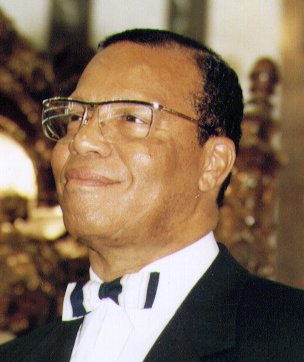 Louis Farrakhan in 2005 Within days the question of who bore responsibility for the assassination was being publicly debated. On February 23, James Farmer, leader of the Congress of Racial Equality, announced at a news conference that local drug dealers, and not the Nation of Islam, were to blame.[256] Others accused the NYPD, the FBI, or the CIA, citing the lack of police protection, the ease with which the assassins entered the Audubon Ballroom, and the failure of the police to preserve the crime scene.[257][258] Earl Grant, one of Malcolm X's associates who was present at the assassination, later wrote:[259] [A]bout five minutes later, a most incredible scene took place. Into the hall sauntered about a dozen policemen. They were strolling at about the pace one would expect of them if they were patrolling a quiet park. They did not seem to be at all excited or concerned about the circumstances. I could hardly believe my eyes. Here were New York City policemen, entering a room from which at least a dozen shots had been heard, and yet not one of them had his gun out! As a matter of absolute fact, some of them even had their hands in their pockets. In the 1970s, the public learned about COINTELPRO and other secret FBI programs established to infiltrate and disrupt civil rights organizations during the 1950s and 1960s.[260] Louis Lomax wrote that John Ali, national secretary of the Nation of Islam, was a former FBI agent.[204] Malcolm X had confided to a reporter that Ali exacerbated tensions between him and Elijah Muhammad and that he considered Ali his "archenemy" within the Nation of Islam leadership.[204] Ali had a meeting with Talmadge Hayer, one of the men convicted of killing Malcolm X, the night before the assassination.[261] The Shabazz family are among those who have accused Louis Farrakhan of involvement in Malcolm X's assassination.[262][263][264][265][266] In a 1993 speech Farrakhan seemed to acknowledge the possibility that the Nation of Islam was responsible:[267][268] Was Malcolm your traitor or ours? And if we dealt with him like a nation deals with a traitor, what the hell business is it of yours? A nation has to be able to deal with traitors and cutthroats and turncoats. In a 60 Minutes interview that aired during May 2000, Farrakhan stated that some things he said may have led to the assassination of Malcolm X. "I may have been complicit in words that I spoke," he said, adding "I acknowledge that and regret that any word that I have said caused the loss of life of a human being."[269] A few days later Farrakhan denied that he "ordered the assassination" of Malcolm X, although he again acknowledged that he "created the atmosphere that ultimately led to Malcolm X's assassination."[270] No consensus has been reached on who was responsible for the assassination.[271] In August 2014, an online petition was started using the White House online petition mechanism to call on the government to release, without alteration, any files they still held relating to the murder of Malcolm X.[272] In January 2019, members of the families of Malcolm X, John F. Kennedy, Martin Luther King Jr., and Robert F. Kennedy were among dozens of Americans who signed a public statement calling for a truth and reconciliation commission to persuade Congress or the Justice Department to review the assassinations of all four leaders during the 1960s.[273][274] A February 21, 2021, press conference attended by three of Malcolm X's daughters and members of deceased NYPD undercover officer Raymond Wood's family released his authorized posthumous letter that stated in part: "I was told to encourage leaders and members of the civil rights groups to commit felonious acts." The Guardian reports that "The arrests kept the two men from managing door security at the Audubon Ballroom in Washington Heights on the day of the shooting, according to the letter."[275] On February 26, 2021, the daughter of Raymond Wood, Kelly Wood, stated that the letter presented at the February 21 press conference is fake. Kelly Wood stated that the letter was created by her cousin Reggie Wood for attention and book sales.[276] In early 2023, members of Malcolm X's family said they would file a $100 million wrongful death lawsuit against the CIA, the FBI, the NYPD and others for allegedly concealing evidence related to the assassination and for alleged involvement to it.[277] The attorney representing the family is Benjamin Crump.[278] |
暗殺 主な記事 マルコムX暗殺 外部画像 image icon 「The Violent End of the Man Called Malcolm」, LIFE, March 5, 1965. 瀕死のマルコムXの頭を抱いている活動家、ユリ・コチヤマの写真を含む、発砲直後の写真[209]。 1965年2月19日、マルコムXはインタビュアーのゴードン・パークスに対し、イスラム国が積極的に自分を殺そうとしていると語った。1965年2月 21日、彼はマンハッタンのオーデュボン・ボールルームでOAAUの演説の準備をしていた!ポケットから手を出せ!」[210][211][212]と叫 んだ。 マルコムXと彼のボディーガードがその騒ぎを鎮めようとしたとき[M]、男が突進してきて、のこぎりのついたショットガンで彼の胸を1発撃ち[213] [214]、他の2人の男が半自動拳銃を撃ちながらステージに突進してきた。 [211]マルコムXはコロンビア長老病院に到着した直後の午後3時30分に死亡が確認された[212]。検視の結果、最初の散弾銃による10発のバック ショットを含む21発の銃創が胸部、左肩、腕、脚に確認された[215]。 銃撃犯の一人であるイスラム国のメンバー、タルマッジ・ヘイヤー(トーマス・ヘーガンとしても知られる)は警察が到着する前に群衆に殴られた[216] [217]。 目撃者は他の銃撃犯をイスラム国のメンバー、ノーマン3Xバトラーとトーマス15Xジョンソンと特定した[218]。3人とも1966年3月に殺人罪で有 罪判決を受け、終身刑を言い渡された[219][220]。 1977年と1978年に、彼はバトラーとジョンソンの無実を再度主張する宣誓供述書に署名し、ニューアークのモスクNo.25の他の4人のネーション・メンバーを殺人またはその計画の参加者として名指しした[222][223][224][225]。 バトラーは、今日ではムハンマド・アブドゥル・アジズとして知られ、1985年に仮釈放され、1998年にネーションのハーレム・モスクの責任者となった が、彼は無実を主張している[226]。 ジョンソンは獄中でカリル・イスラムと名前を変え、ネーションの教えを拒否し、イスラム教スンニ派に改宗した。1987年に釈放された彼は、2009年8 月に亡くなるまで無実を主張していた[227][228] ハイヤーもまた、服役中にネーションの教えを拒否し、スンニ派イスラム教に改宗した[229]。 2021年、ムハンマド・アブドゥル・アジズとカリル・イスラム(旧ノーマン・3X・バトラーとトーマス・15X・ジョンソン)は、FBIとニューヨーク 市警が裁判中に重要な証拠を隠匿していたことが判明した再審査の結果、殺人罪の嫌疑が晴れた[232]。 2022年7月14日、アジズはブルックリンの連邦地方裁判所にニューヨーク市を相手取り、不当な投獄に関する4000万ドルの損害賠償を求める訴訟を起 こした[233]。 レス・ペインとタマラ・ペインは、ピューリッツァー賞を受賞した伝記『死者は蘇る: The Life of Malcolm X)の中で、暗殺者はニュージャージー州ニューアークにある「ネーション・オブ・イスラム」のモスクのメンバーであったと主張している: ショットガンを撃ったウィリアム25X(ウィリアム・ブラッドリーとしても知られる)、レオン・デイビス、トーマス・ヘイヤーの3人である[234]。 葬儀 2月23日から26日にかけてハーレムのユニティ葬儀場で行われた一般公開には、約14,000人から30,000人の弔問客が訪れた[235]。 2月27日の葬儀では、ハーレムの千人収容のキリスト教会Faith Templeの外にあふれた群集のために拡声器が設置され[236][237]、地元のテレビ局が礼拝の模様を生中継した[238]。 出席した公民権運動の指導者の中には、ジョン・ルイス、バヤード・ラスティン、ジェームズ・フォアマン、ジェームズ・ファーマー、ジェシー・グレイ、アン ドリュー・ヤングがいた[236][239]。俳優で活動家のオジー・デイヴィスは弔辞を述べ、マルコムXを「私たちの輝く黒人の王子......彼は私 たちをとても愛していたので、死ぬことをためらわなかった」と評した: 黒人の友人として、彼を非難し、彼の思い出の前からさえも逃げ去り、激動の時代の歴史から彼を抹殺することで自分たちを救えと言う人たちがいる。ハーレム は、この嵐のような、物議を醸す、大胆な若きキャプテンのどこに敬意を表するところがあるのか、と多くの人は問うだろう。彼は人間ではなく、悪魔であり、 怪物であり、破壊者であり、黒人の敵だからだ。彼らは、彼は憎悪の塊だ、狂信者だ、人種差別主義者だ、と言うだろう!そして我々は彼らにこう答えるだろ う: マルコム兄弟と話したことがあるか?彼に触れたことがあるか、彼に微笑みかけられたことがあるか?彼の話を本当に聞いたことがあるか?彼が意地悪なことを したことがあったか?彼自身が暴力や世間を騒がせたことがあったか?もしそうなら、あなたは彼を知っているはずだ。そして、彼を知っていれば、なぜ私たち が彼を称えなければならないのかがわかるはずだ......。そして、彼を称えることで、私たちは私たち自身の中の最良のものを称えることになる」 [240]。 マルコムXはニューヨーク州ハーツデールのファーンクリフ墓地に埋葬された[238]。友人たちは墓掘り人のシャベルを手に取り、自分たちで埋葬を完了させた[241]。 俳優で活動家のルビー・ディーとフアニータ・ポワチエ(シドニー・ポワチエの妻)は、彼の家族のための家と彼の子供たちの教育のための資金を集めるために、憂慮する母親委員会を設立した[242]。 反応 マルコムXの暗殺に対する反応は様々であった。マーティン・ルーサー・キング・ジュニアはベティ・シャバズへの電報の中で、「あなたの夫の衝撃的で悲劇的な暗殺」に悲しみを表明した[243]。 私たちは人種問題を解決する方法について常に意見が一致していたわけではなかったが、私はいつもマルコムに深い愛情を抱いていたし、彼には問題の存在と根 源を突き止める素晴らしい能力があると感じていた。彼は自分の主張を雄弁に語る代弁者であり、マルコムが人種として直面する問題に大きな関心を寄せていた ことを疑う者はいない。 イライジャ・ムハンマドは2月26日に行われた救世主の日の年次大会において、「マルコムXは説いたとおりのことを得た」と語ったが、殺人との関わりは否 定した[244]。「マルコムを殺したかったわけではないし、殺そうとしたわけでもない」とムハンマドは語り、「そのような無知で愚かな教えは、彼自身の 最期を招くことを知っている」と付け加えた[245]。 マルコムXの友人であった作家のジェームズ・ボールドウィンは、暗殺のニュースを聞いたときロンドンにいた。マルコムXの友人であった作家のジェイムズ・ ボールドウィンは、暗殺のニュースをロンドンで聞いた!この男が死んだのは、白人至上主義を生み出したあなたたちのせいだ。君たちに罪はないが、君たちが やったのだ......。君たちの工場、君たちの都市、君たちが大陸をレイプしたことがすべての始まりなのだ」[246]。 ニューヨーク・ポスト紙は、「彼の最も鋭い批評家たちでさえも、彼の素晴らしさを認めていた↪0)しばしば荒々しく、予測不可能で、風変わりで、それにも かかわらず、今は実現されないままであるに違いない将来性を持っていた」と書いた[247]。 ニューヨーク・タイムズ紙は、マルコムXは「非凡でひねくれた男」であり、「多くの真の才能を邪悪な目的に向けた」人物であり、彼の人生は「奇妙に、哀れ なほど無駄になった」と書いた[248]。 ナイジェリアの『デイリー・タイムズ』紙は、マルコムXは「殉教者の宮殿に名を連ねるだろう」と書いた[251]。 ガーナの『タイムズ』紙は、彼をジョン・ブラウン、メドガー・エヴァース、パトリス・ルムンバになぞらえ、「自由のために殉教したアフリカ人とアメリカ人 の数々」の中に数えた[252][253]。 中国では、人民日報はマルコムXをアメリカの「支配層と人種差別主義者」によって殺された殉教者であるとし、彼の暗殺は「帝国主義の抑圧者に対処するため には、暴力には暴力で応じなければならない」ことを示したと書いている。 253]同じく北京で発行されている『光明日報』は、「マルコムは自由と平等な権利のために戦ったために殺害された」と述べている[254]。キューバで は、『エル・ムンド』が暗殺を「差別との闘いを暴力によって根絶しようとする、もうひとつの人種差別主義者の犯罪」と評している[250]。 キング牧師は『ニューヨーク・アムステルダム・ニュース』に毎週寄稿しているコラムで、マルコムXとその暗殺について次のように振り返っている[255]。 マルコムXが公人として脚光を浴びるようになったのは、部分的には『憎しみが生んだ憎しみ』というタイトルのテレビ・ドキュメンタリーの結果であった。このタイトルは、マルコムの生と死の本質を指し示している。 マルコムXは明らかに、この国における黒人の殺伐とした存在に投じられた憎悪と暴力の産物だった......。 彼の青春時代には、希望も、説教も、非暴力の教えも、運動もなかった......。 裏社会の皇帝になれず、意味と運命を求めて何度も宗教に目を向けたのは、マルコムの個人的な深さと誠実さの証しである。残忍で無意味な暗殺が行われたとき、マルコムはまだ転向し、成長していた......。 ルムンバの殺害と同様、マルコムXの殺害は、潜在的に偉大な指導者を世界から奪った。私はこの2人のどちらにも賛成することはできなかったが、彼らの中に尊敬に値するリーダーシップの能力を見ることができた。 陰謀疑惑  2005年のルイス・ファラカン 数日のうちに、誰が暗殺の責任を負うのかという問題が公に議論されるようになった。2月23日、「人種平等会議」のリーダー、ジェームズ・ファーマーは記 者会見で、「イスラム国」ではなく地元の麻薬ディーラーのせいだと発表した[256]。 [256]他の者たちはニューヨーク市警、FBI、またはCIAを非難し、警察の保護の欠如、暗殺者がオーデュボン・ボールルームに容易に侵入したこと、 警察が犯行現場を保存しなかったことを挙げた[257][258]。 暗殺に立ち会ったマルコムXの仲間の一人であるアール・グラントは後に次のように書いている[259]。 [5分ほどして、信じられないような光景が起こった。ホールには12人ほどの警官が入ってきた。彼らは静かな公園をパトロールしているのだろうと思われるくらいのペースで散歩していた。彼らはまったく興奮する様子もなく、状況を気にする様子もない。 私は自分の目を疑った。ニューヨークの警官が、少なくとも十数発の銃声が聞こえる部屋に入っていった!絶対的な事実として、何人かはポケットに手を突っ込んでいた。 1970年代、一般大衆は1950年代から1960年代にかけて公民権団体に潜入し、混乱させるために設立されたコイントエルプロ (COINTELPRO)やその他のFBIの秘密プログラムについて知った[260]。ルイス・ローマックスは、「イスラム国」の全国書記ジョン・アリが 元FBI捜査官だったと書いている[204]。 [204]マルコムXは、アリが彼とイライジャ・ムハンマドの間の緊張を悪化させ、アリをイスラム教国指導部内の「宿敵」とみなしていることを記者に打ち 明けた[204]。アリは暗殺の前夜、マルコムX殺害で有罪判決を受けた男の一人であるタルマッジ・ヘイヤーと面会していた[261]。 シャバズ・ファミリーは、マルコムXの暗殺にルイ・ファラカンが関与していると非難している人々の一人である[262][263][264][265] [266] 1993年のスピーチで、ファラカンはイスラム教国に責任がある可能性を認めているようであった[267][268]。 マルコムはあなた方の裏切り者だったのか、それとも我々の裏切り者だったのか?もし我々が国家が裏切り者に対処するように彼に対処したのなら、お前たちには関係ないだろう?国家は裏切り者や裏切り者に対処できなければならない。 2000年5月に放映された60ミニッツのインタビューで、ファラカンは、自分の発言がマルコムXの暗殺につながったかもしれないと述べた。「自分が話し た言葉に加担してしまったかもしれない。 「269]数日後、ファラカンはマルコムXの「暗殺を命じた」ことは否定したが、「最終的にマルコムXの暗殺につながる雰囲気を作った」ことは再び認めた [270]。 暗殺の責任者についてコンセンサスは得られていない[271]。 2014年8月、ホワイトハウスのオンライン請願機構を利用したオンライン請願が開始され、マルコムX殺害に関連して政府がまだ保持しているファイルを改 変することなく公開するよう求めた[272]、 とロバート・F・ケネディの遺族は、1960年代における4人の指導者全員の暗殺を見直すよう議会または司法省を説得する真実和解委員会を求める数十人の アメリカ人のうちの一人であった[273][274]。 2021年2月21日、マルコムXの3人の娘と死亡したニューヨーク市警の潜入捜査官レイモンド・ウッドの家族が出席した記者会見で、彼の公認の遺書が公 開された: 「私は公民権団体のリーダーやメンバーに重罪を犯すよう促すよう言われた」 Guardian』紙は、「逮捕されたことで、手紙によれば、2人は銃撃事件の当日、ワシントン・ハイツのオーデュボン・ボールルームでドアの警備を管理 することができなくなった」と報じている[275]。2021年2月26日、レイモンド・ウッドの娘ケリー・ウッドは、2月21日の記者会見で発表された 手紙は偽物であると述べた。ケリー・ウッドは、この手紙は彼女のいとこであるレジー・ウッドが注目され、本を売るために作ったものだと述べた[276]。 2023年初頭、マルコムXの遺族は、暗殺に関連する証拠を隠し、それに関与したとされるCIA、FBI、ニューヨーク市警などに対し、1億ドルの不法死亡訴訟を起こすと述べた[277]。 |
| Philosophy Except for his autobiography, Malcolm X left no published writings. His philosophy is known almost entirely from the many speeches and interviews he gave from 1952 until his death.[279] Many of those speeches, especially from the last year of his life, were recorded and have been published.[280] Beliefs of the Nation of Islam Further information: Beliefs and theology of the Nation of Islam The white liberal differs from the white conservative only in one way: the liberal is more deceitful than the conservative. —Malcolm X[281] While he was a member of the Nation of Islam, Malcolm X taught its beliefs, and his statements often began with the phrase "The Honorable Elijah Muhammad teaches us that ..."[282] It is virtually impossible now to discern whether Malcolm X's personal beliefs at the time diverged from the teachings of the Nation of Islam.[283][N] After he left the Nation in 1964, he compared himself to a ventriloquist's dummy who could only say what Elijah Muhammad told him to say.[282][O] Malcolm X taught that Black people were the original people of the world,[101] and that Whites were a race of devils who were created by an evil scientist named Yakub.[102] The Nation of Islam believed that Black people were superior to White people and that the demise of the White race was imminent.[103] When questioned concerning his statements that White people were devils, Malcolm X said: "history proves the White man is a devil."[286] "Anybody who rapes, and plunders, and enslaves, and steals, and drops hell bombs on people ... anybody who does these things is nothing but a devil," he said.[287] Malcolm X said that Islam was the "true religion of Black mankind" and that Christianity was "the White man's religion" that had been imposed upon African Americans by their slave-masters.[288] He said that the Nation of Islam followed Islam as it was practiced around the world, but the Nation's teachings varied from those of other Muslims because they were adapted to the "uniquely pitiful" condition of Black people in the United States.[289] He taught that Wallace Fard Muhammad, the founder of the Nation, was God incarnate,[290] and that Elijah Muhammad was his Messenger, or Prophet.[P] While the civil rights movement fought against racial segregation, Malcolm X advocated the complete separation of Blacks from Whites.[102][103] The Nation of Islam proposed the establishment of a separate country for African Americans in the southern[114] or southwestern United States[293] as an interim measure until African Americans could return to Africa.[115] Malcolm X suggested the United States government owed reparations to Black people for the unpaid labor of their ancestors.[294] He also rejected the civil rights movement's strategy of nonviolence, advocating instead that Black people should defend themselves.[116] Palestine In 1959, Malcolm X visited and met with religious leaders at Al-Aqsa mosque as a representative of Elijah Muhammad.[295] In 1964, X visited the Khan Younis refugee camp in Gaza where he visited a local hospital and dined with religious leaders in Gaza. He also met Palestinian poet, Harun Hashem Rashid, who recounted to him how he narrowly escaped the Khan Younis massacre of 1956. A few weeks later, Malcolm X headed to Cairo where he met with members of the Palestinian Liberation Organization.[295] These meetings and experiences inspired Malcolm X to write an essay entitled "Zionist Logic" that was published in the Egyptian Gazette.[295] In this essay Malcolm X explained how the "present occupation of Arab Palestine has no intelligent or legal basis in history" and described how Zionism was essentially a colonial and imperialist project:[296] The ever-scheming European imperialists wisely placed Israel where she could geographically divide the Arab world, infiltrate and sow the seed of dissension among African leaders and also divide the Africans against the Asians. Following his return to the United States, Malcolm X continued to speak about the issue of Palestine describing in 1965 in one of his speeches in Detroit how "We need a free Palestine... We don't need a divided Palestine. We need a whole Palestine."[297] Independent views The common goal of 22 million Afro-Americans is respect as human beings. ... We can never get civil rights in America until our human rights are first restored. We will never be recognized as citizens there until we are first recognized as humans. ... Just as the violation of human rights of our brothers and sisters in South Africa and Angola is an international issue and has brought the racists of South Africa and Portugal under attack from all other independent governments at the United Nations, once the miserable plight of the 22 million Afro-Americans is also lifted to the level of human rights our struggle then becomes an international issue and the direct concern of all other civilized governments. We can then take the racist American Government before the World Court and have the racists in it exposed and condemned as the criminals that they are. —Malcolm X[298] After leaving the Nation of Islam, Malcolm X announced his willingness to work with leaders of the civil rights movement,[148] though he advocated some changes to their policies. He felt that calling the movement a struggle for civil rights would keep the issue within the United States while changing the focus to human rights would make it an international concern. The movement could then bring its complaints before the United Nations, where Malcolm X said the emerging nations of the world would add their support.[299] Malcolm X argued that if the U.S. government was unwilling or unable to protect Black people, Black people should protect themselves. He said that he and the other members of the OAAU were determined to defend themselves from aggressors, and to secure freedom, justice and equality "by whatever means necessary".[300] 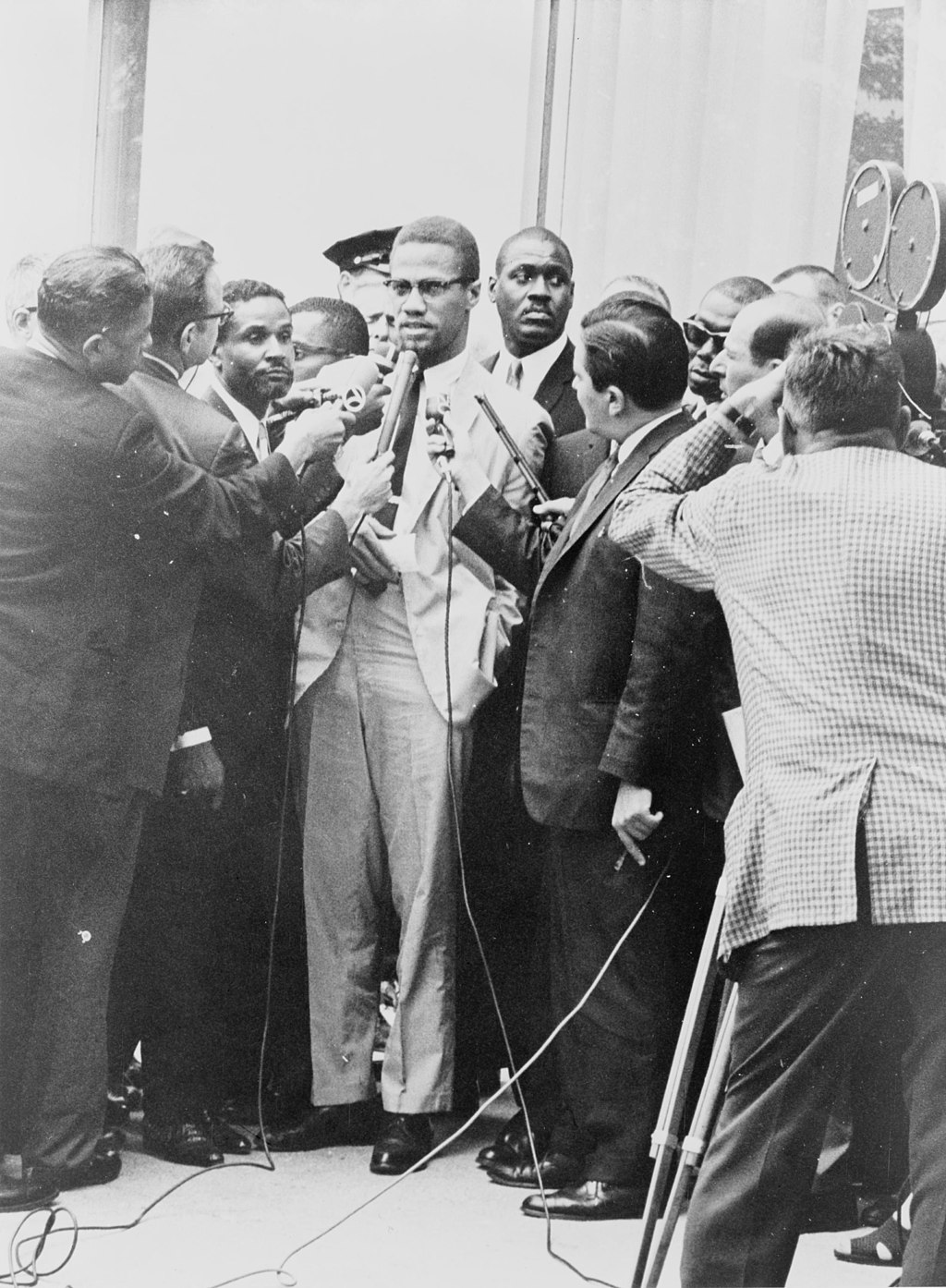 Malcolm X is surrounded by reporters with microphones, while a television camera captures the scene Malcolm X at a 1964 press conference Malcolm X stressed the global perspective he gained from his international travels. He emphasized the "direct connection" between the domestic struggle of African Americans for equal rights with the independence struggles of Third World nations.[301] He said that African Americans were wrong when they thought of themselves as a minority; globally, Black people were the majority.[302] In his speeches at the Militant Labor Forum, which was sponsored by the Socialist Workers Party, Malcolm X criticized capitalism.[193] After one such speech, when he was asked what political and economic system he wanted, he said he did not know, but that it was no coincidence the newly independent countries in the Third World were turning toward socialism.[303] When a reporter asked him what he thought about socialism, Malcolm X asked whether it was good for Black people. When the reporter told him it seemed to be, Malcolm X told him: "Then I'm for it."[303][304] Although he no longer called for the separation of Black people from White people, Malcolm X continued to advocate Black nationalism, which he defined as self-determination for the African-American community.[305] In the last months of his life, however, Malcolm X began to reconsider his support for Black nationalism after meeting northern African revolutionaries who, to all appearances, were White.[306] After his Hajj, Malcolm X articulated a view of White people and racism that represented a deep change from the philosophy he had supported as a minister of the Nation of Islam. In a famous letter from Mecca, he wrote that his experiences with White people during his pilgrimage convinced him to "rearrange" his thinking about race and "toss aside some of [his] previous conclusions".[307] In a conversation with Gordon Parks, two days before his assassination, Malcolm said: [L]istening to leaders like Nasser, Ben Bella, and Nkrumah awakened me to the dangers of racism. I realized racism isn't just a Black and White problem. It's brought bloodbaths to about every nation on earth at one time or another. Brother, remember the time that White college girls came into the restaurant—the one who wanted to help the [Black] Muslims and the Whites get together—and I told her there wasn't a ghost of a chance and she went away crying? Well, I've lived to regret that incident. In many parts of the African continent, I saw White students helping Black people. Something like this kills a lot of argument. I did many things as a [Black] Muslim that I'm sorry for now. I was a zombie then—like all [Black] Muslims—I was hypnotized, pointed in a certain direction and told to march. Well, I guess a man's entitled to make a fool of himself if he's ready to pay the cost. It cost me 12 years. That was a bad scene, brother. The sickness and madness of those days—I'm glad to be free of them.[308] Purported bisexuality In recent years, some researchers have alleged that Malcolm X was bisexual. These claims are founded upon the work of late Columbia University historian Manning Marable, and his controversial 2011 book Malcolm X: A Life of Reinvention. In the book, Marable asserted that "Malcolm X had exaggerated his early criminal career and had engaged in an early homosexual relationship with a White businessman."[309] Scholar Christopher Phelps agreed with Marable in the Journal of American Studies: "Malcolm Little did take part in sex acts with male counterparts. If set in the context of the 1930s and 1940s, these acts position him not as a 'homosexual lover,' as has been asserted, but in the pattern of 'straight trade'—heterosexual men open to sex with homosexuals—an understanding that in turn affords insights into the Black revolutionary's mature masculinity."[310] Malcolm X's family has rejected these allegations about his personal life. His daughter Ilyasah Shabazz said she would have known about these encounters before abruptly walking out on an interview on NPR. Shabazz said: "I think the things that I take issue with are the fact that he said my father engaged in a bisexual relationship, a homo—you know, he had a gay lover who was an elder White businessman, I think, in his late 50s when my father was in his teens. And, you know, my father was an open book. And we actually have four of the missing chapters from the autobiography. And, you know, he is very clear in his activities, which nothing included being gay. And certainly he didn't have anything against gay—he was for human rights, human justice, you know. So if he had a gay encounter, he likely would've talked about it. And what he did talk about was someone else's encounter."[311] |
哲学 自伝を除いて、マルコムXは出版された著作を残していない。彼の哲学は、1952年から亡くなるまで彼が行った多くの演説やインタビューからほぼ完全に知られている[279]。これらの演説の多く、特に晩年のものは録音され、出版されている[280]。 ネーション・オブ・イスラムの信条 さらに詳しい情報 イスラム教国の信条と神学 白人のリベラル派が白人の保守派と違うのは、ただ一つの点だけである。 -マルコムX[281]。 マルコムXはイスラム教国(ネーション・オブ・イスラム)のメンバーでありながら、その信条を教え、彼の発言はしばしば「高名なイライジャ・ムハンマドは 私たちにこう教えている」というフレーズで始まった[282]。 「282]当時のマルコムXの個人的な信条がイスラム教ネーションの教えと乖離していたかどうかを見分けることは、今では事実上不可能である[283] [N]。1964年にネーションを脱退した後、彼は自分自身をイライジャ・ムハンマドに言われたことしか言えない腹話術の人形に例えた[282][O]。 マルコムXは、黒人は世界のオリジナルな人々であり[101]、白人はヤクブという邪悪な科学者によって創造された悪魔の種族であると教えていた [102]。 イスラーム教団は、黒人は白人より優れており、白人の滅亡は間近であると信じていた[103]。白人は悪魔であるという発言に関して質問されたとき、マル コムXはこう言った: 「歴史は白人が悪魔であることを証明している」[286]、「強姦し、略奪し、奴隷にし、盗み、人々に地獄の爆弾を落とす......こうしたことをする 者は誰でも悪魔以外の何者でもない」と彼は言った[287]。 マルコムXは、イスラム教は「黒人の真の宗教」であり、キリスト教は奴隷主人によってアフリカ系アメリカ人に押し付けられた「白人の宗教」であると言っ た。 [288]彼は、ネーション・オブ・イスラムは世界中で実践されているイスラム教に従っているが、ネーションの教えは、アメリカにおける黒人の「独特に哀 れな」状況に適応しているため、他のイスラム教の教えとは異なっていると述べた[289]。彼は、ネーションの創始者であるウォレス・ファード・ムハンマ ドは神の化身であり[290]、イライジャ・ムハンマドはその使徒(預言者)であると説いた[P]。 公民権運動が人種隔離と戦う一方で、マルコムXは黒人と白人の完全な分離を提唱した[102][103]。 ネーション・オブ・イスラムは、アフリカ系アメリカ人がアフリカに戻ることができるまでの暫定措置として、アメリカ南部[114]または南西部[293] にアフリカ系アメリカ人のための独立した国を設立することを提案した。 [115]マルコムXは、アメリカ政府が黒人に対して彼らの祖先の未払い労働に対する賠償金を支払う義務があることを示唆した[294]。 彼はまた公民権運動の非暴力という戦略を否定し、代わりに黒人は自分自身を守るべきだと提唱した[116]。 パレスチナ 1959年、マルコムXはイライジャ・ムハンマドの代理としてアル・アクサ・モスクを訪れ、宗教指導者たちと会談した[295]。1964年、Xはガザの カーン・ユーニス難民キャンプを訪れ、地元の病院を訪問し、ガザの宗教指導者たちと食事をした。彼はまたパレスチナの詩人ハルン・ハシェム・ラシッドに会 い、1956年のカン・ユーニスの大虐殺から間一髪で逃れたことを語った。数週間後、マルコムXはカイロに向かい、そこでパレスチナ解放機構のメンバーと 会った[295]。これらの出会いと経験に触発され、マルコムXは『エジプト公報』に掲載された「シオニストの論理」と題するエッセイを書いた [295]。このエッセイの中でマルコムXは、「現在のアラブ・パレスチナの占領が、歴史上、知的根拠も法的根拠もない」ことを説明し、シオニズムが本質 的に植民地主義的・帝国主義的プロジェクトであることを次のように述べた[296]。 常に策謀をめぐらすヨーロッパの帝国主義者たちは、イスラエルをアラブ世界を地理的に分断できる場所に賢く配置し、アフリカの指導者たちに浸透して不和の種をまき、アフリカ人をアジア人に対しても分断した。 アメリカに戻ったマルコムXは、パレスチナの問題について語り続け、1965年にデトロイトで行った演説の中で、「我々は自由なパレスチナを必要としている。分断されたパレスチナは必要ない。パレスチナ全体が必要なのだ」[297]。 独立した見解 2,200万人のアフロ・アメリカンの共通の目標は、人間としての尊重である。... 私たちの人権がまず回復されない限り、アメリカで市民権を得ることはできない。私たちがまず人間として認められるまでは、そこで市民として認められることは決してないだろう。... 南アフリカとアンゴラの兄弟姉妹の人権侵害が国際的な問題であり、南アフリカとポルトガルの人種差別主義者を国連で他のすべての独立政府から攻撃させたよ うに、いったん2200万人のアフロ・アメリカンの悲惨な窮状が人権のレベルまで引き上げられれば、私たちの闘いは国際的な問題となり、他のすべての文明 政府の直接的な関心事となる。そうすれば、人種差別主義者のアメリカ政府を世界法廷に提訴し、その中の人種差別主義者を犯罪者として暴露し、断罪させるこ とができる。 -マルコムX[298] ネーション・オブ・イスラムを脱退した後、マルコムXは公民権運動の指導者たちと協力する意志を表明したが[148]、彼らの政策にいくつかの変更を加え ることを提唱した。彼は、この運動を公民権闘争と呼ぶことで、問題を米国内に留めることができ、一方で人権に焦点を変えることで、国際的な関心事になると 考えた。そうすれば、運動は国連に苦情を訴えることができ、そこで世界の新興国が支持を加えるだろうとマルコムXは言った[299]。 マルコムXは、もしアメリカ政府が黒人を守る気がなかったり、守れなかったりするのであれば、黒人は自分自身を守るべきだと主張した。彼とOAAUの他の メンバーは、侵略者から自分たちを守り、「必要な手段は何でも」自由と正義と平等を確保する決意を固めていると語った[300]。  マルコムXはマイクを持った記者たちに囲まれ、テレビカメラがその様子を撮影している。 1964年の記者会見でのマルコムX マルコムXは、海外旅行で得たグローバルな視点を強調した。彼は、アフリカ系アメリカ人の平等な権利を求める国内の闘争と第三世界の国々の独立闘争との 「直接的なつながり」を強調した[301]。彼は、アフリカ系アメリカ人が自分たちを少数派だと考えているのは間違いであり、世界的には黒人が多数派であ ると述べた[302]。 社会主義労働者党が主催するミリタント・レイバー・フォーラムでの演説の中で、マルコムXは資本主義を批判した[193]。 そのような演説の後、どのような政治経済体制を望むかと尋ねられたとき、彼はわからないと答えたが、第三世界の新しく独立した国々が社会主義に向かってい るのは偶然ではないと答えた[303]。記者が、社会主義は黒人にとって良いことなのかと尋ねると、マルコムXはそうだと答えた: 「それなら賛成だ」[303][304]。 彼はもはや黒人と白人の分離を主張することはなかったが、マルコムXはアフリカ系アメリカ人コミュニティの自決と定義する黒人ナショナリズムを提唱し続け た[305]。しかし、マルコムXは晩年、どう見ても白人であるアフリカ北部の革命家たちに会ってから、黒人ナショナリズムへの支持を考え直すようになっ た[306]。 ハッジの後、マルコムXは白人と人種差別に対する見解を明確にし、それは彼がネーション・オブ・イスラムの牧師として支持していた哲学からの深い変化を表 していた。メッカからの有名な手紙の中で、彼は巡礼中の白人たちとの経験によって、人種についての考え方を「整理し直し」、「以前の結論のいくつかを捨て 去る」ことを確信したと書いている[307]。暗殺される2日前のゴードン・パークスとの会話の中で、マルコムはこう語っている: [ナセル、ベン・ベラ、ンクルマのような指導者の話を聞いて、人種差別の危険性に目覚めた。人種差別は白人と黒人だけの問題ではない。人種差別は、地球上のあらゆる国に一度や二度は血の海をもたらした。 ブラザー、白人の女子大生がレストランに来た時のことを覚えているかい?200Dはイスラム教徒と白人が一緒になるのを助けたいと言ったんだ。まあ、私は その出来事を後悔しながら生きてきた。アフリカ大陸の多くの場所で、私は白人の学生が黒人を助けているのを見た。このようなことは、多くの議論を殺してし まう。黒人]ムスリムとして、今になって反省するようなことをたくさんした。当時、私はゾンビだったすべての【黒人】ムスリムと同じように催眠術をか けられ、ある方向を指さされ、行進するように言われた。その代償を払う覚悟があるのなら、馬鹿にする権利はある。私は12年かかった。 ひどい光景だったよ、兄弟。あの頃の病気と狂気❔それから解放されて嬉しいよ[308]」。 バイセクシュアル疑惑 近年、マルコムXはバイセクシュアルであったと主張する研究者がいる。こうした主張は、コロンビア大学の歴史家である故マニング・マラブルの研究と、物議 を醸した2011年の著書『Malcolm X: A Life of Reinvention』に基づいている。この本の中で、マレイブルは「マルコムXは初期の犯罪歴を誇張し、白人実業家と初期の同性愛関係にあった」と主 張した[309]。 学者のクリストファー・フェルプスは『Journal of American Studies』誌でマラブルに同意している: 「マルコム・リトルは男性との性行為に参加していた。1930年代と1940年代という文脈で考えれば、これらの行為は彼を、これまで主張されてきたよう な 「同性愛の恋人 」としてではなく、「ストレート・トレード」——同性愛者とのセックスに寛容な異性愛者の男性——というパターンの中に位置づけるものであり、その理解は ひいては黒人革命家の成熟した男性性についての洞察を与えるものである」[310]。 マルコムXの家族は、彼の私生活に関するこれらの疑惑を否定している。娘のイリヤサ・シャバズは、NPRのインタビューから突然立ち去る前に、これらの出 会いについて知っていただろうと語った。シャバズは言う: 「私が問題にしているのは、父がバイセクシュアルの関係、つまりホモの関係、つまり父が10代の頃に50代後半の白人実業家の長老と思われるゲイの恋人が いたと言っていることだ。そして、父はオープンな人だった。自叙伝の欠けている4つの章があるんだ。そしてね、彼は自分の活動において非常に明確で、ゲイ であることは含まれていなかった。彼は人権や人間の正義を支持していたんだ。だから、もしゲイとの出会いがあったなら、おそらくそのことを話しただろう。 そして彼が話したのは、他の誰かの出会いだった」[311]。 |
| Legacy Malcolm X has been described as one of the greatest and most influential African Americans in history.[312][313][314] He is credited with raising the self-esteem of Black Americans and reconnecting them with their African heritage.[315] He is largely responsible for the spread of Islam in the Black community in the United States.[316][317][318] Many African Americans, especially those who lived in cities in the Northern and Western United States, felt that Malcolm X articulated their complaints concerning inequality better than did the mainstream civil rights movement.[118][119] One biographer says that by giving expression to their frustration, Malcolm X "made clear the price that White America would have to pay if it did not accede to Black America's legitimate demands."[319] In the late 1960s, increasingly radical Black activists based their movements largely on Malcolm X and his teachings. The Black Power movement,[68][320] the Black Arts Movement,[68][321] and the widespread adoption of the slogan "Black is beautiful"[322] can all trace their roots to Malcolm X. In 1963, Malcolm X began a collaboration with Alex Haley on his life story, The Autobiography of Malcolm X.[147] He told Haley, "If I'm alive when this book comes out, it will be a miracle."[323] Haley completed and published it some months after the assassination.[324] During the late 1980s and early 1990s, there was a resurgence of interest in his life among young people. Hip-hop groups such as Public Enemy adopted Malcolm X as an icon,[325] and his image was displayed in hundreds of thousands of homes, offices, and schools,[326] as well as on T-shirts and jackets.[327] In 1986 Ella Little-Collins merged the Organization of Afro-American Unity with the African American Defense League.[328] In 1992 the film Malcolm X, an adaptation of The Autobiography of Malcolm X, was released,.[329] In 1998, Time named The Autobiography of Malcolm X one of the ten most influential nonfiction books of the 20th century.[330] Malcolm X was an inspiration for several fictional characters. He was fictionalized as the character Minister Q in the 1967 novel The Man Who Cried I Am by John A. Williams.[331] The Marvel Comics writer Chris Claremont confirmed that Malcolm X was an inspiration for the X-Men character Magneto, while Martin Luther King was an inspiration for Professor X.[332][333][334] Malcolm X also inspired the character Erik Killmonger in the film Black Panther.[335][336] Memorials and tributes 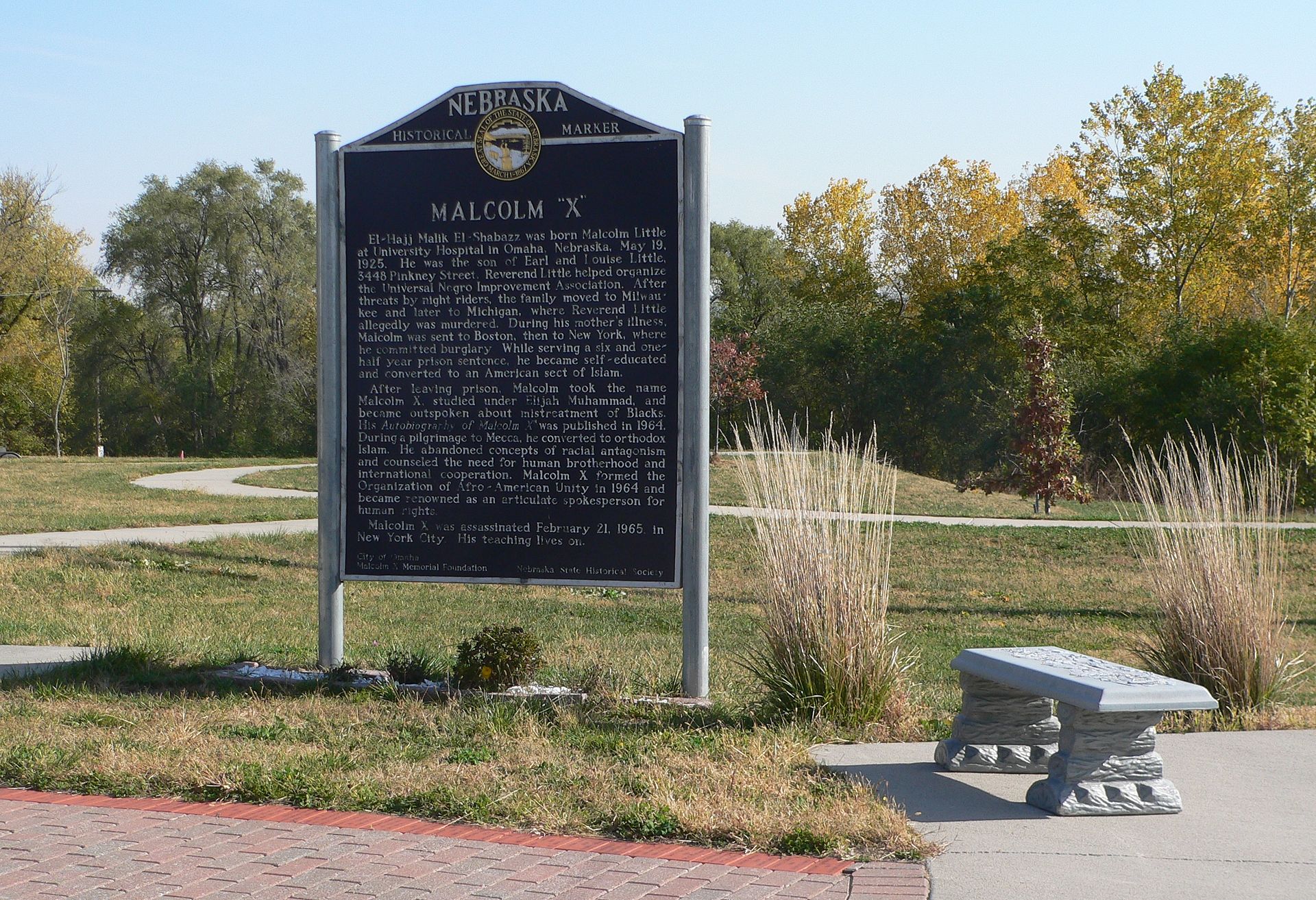 A historical marker for Malcolm X's first home in Omaha, Nebraska, which was torn down in 1965. The house that once stood at 3448 Pinkney Street in North Omaha, Nebraska, was the first home of Malcolm Little with his birth family. The house was torn down in 1965 by new owners who did not know of its connection with Malcolm X.[337] The site was listed on the National Register of Historic Places in 1984.[338][339][340] A Nebraska Historical Marker now marks the site. The Malcolm X—Ella Little-Collins House in the Roxbury section of Boston, Massachusetts, where Malcolm X lived with his half-sister Ella Little-Collins and began getting involved in the Nation of Islam,[341] was added to the National Register of Historic Places in 2021.[342] Several archaeological surveys have been performed on the house's grounds, and there are ongoing efforts to preserve the site.[343] In 1968, twelve black students who occupied North Hall at University of California, Santa Barbara temporarily renamed it Malcom X Hall to force the administration to acknowledge the needs of black students. As a result, UCSB created the Department of Black Studies.[344][345] 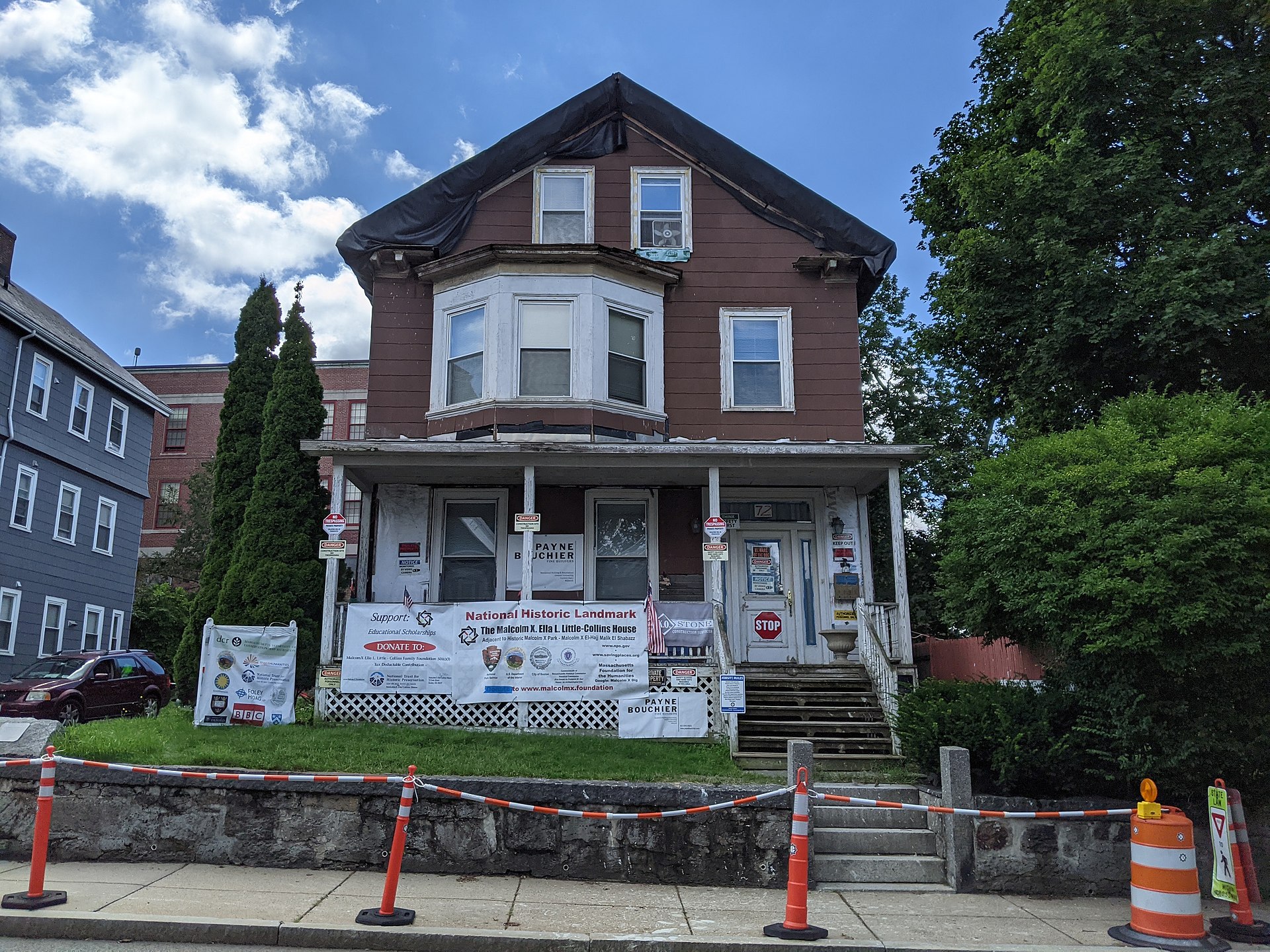 The Malcolm X—Ella Little-Collins House in Boston where Malcolm X and his half-sister Ella Little-Collins lived from 1941 to 1944. In Lansing, Michigan, a Michigan Historical Marker was erected in 1975 on Malcolm Little's childhood home.[346] The city is also home to El-Hajj Malik El-Shabazz Academy, a public charter school with an Afrocentric focus. The school is located in the building where Little attended elementary school.[347] In cities across the United States, Malcolm X's birthday (May 19) is commemorated as Malcolm X Day. The first known celebration of Malcolm X Day took place in Washington, D.C., in 1971.[348] The city of Berkeley, California, has recognized Malcolm X's birthday as a citywide holiday since 1979.[349] 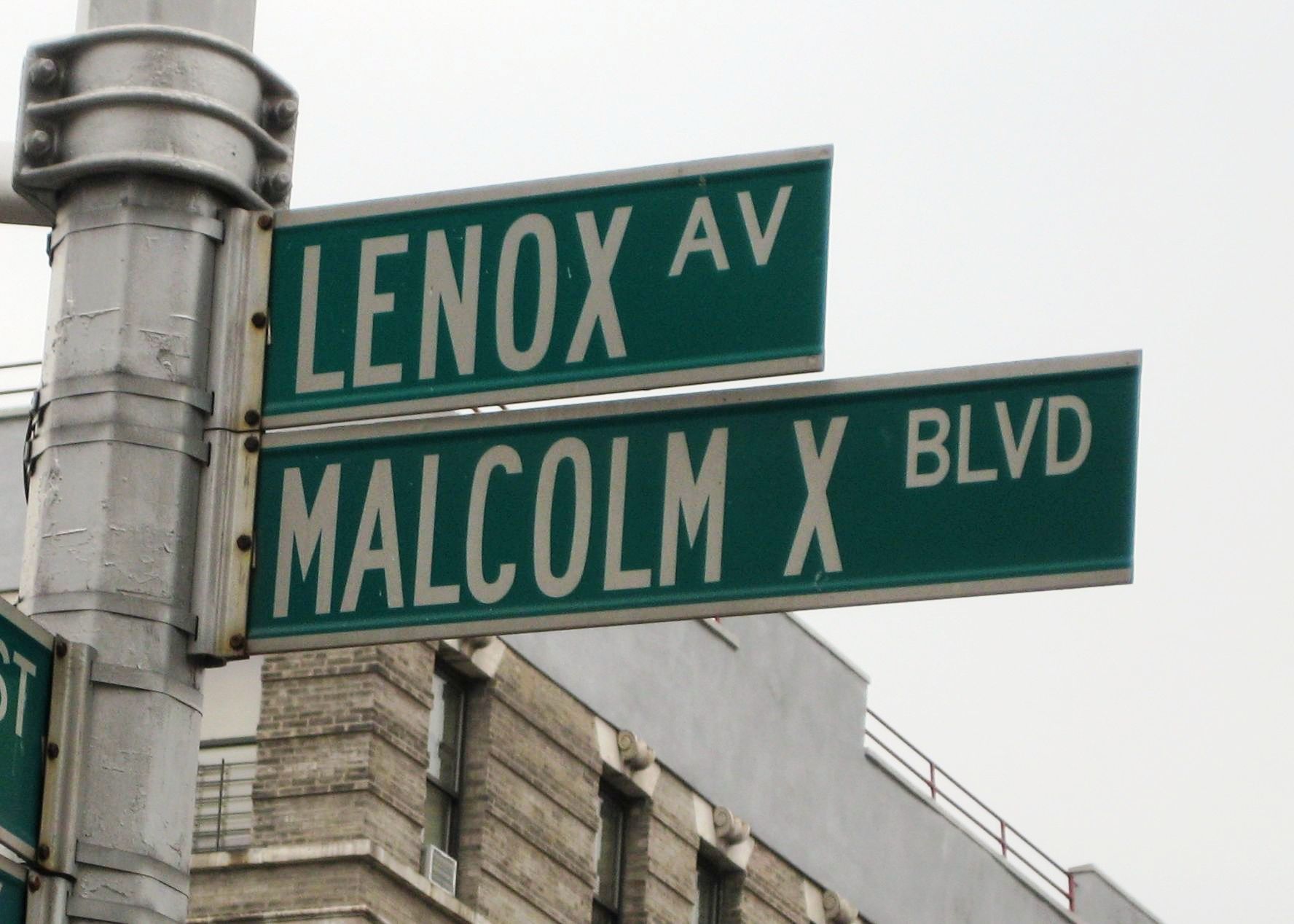 Two green street signs, one reading Lenox Avenue, the other reading Malcolm X Boulevard Malcolm X Boulevard in New York City Many cities have renamed streets after Malcolm X. In 1987, New York mayor Ed Koch proclaimed Lenox Avenue in Harlem to be Malcolm X Boulevard.[350] The name of Reid Avenue in Brooklyn, New York, was changed to Malcolm X Boulevard in 1985.[351][352] Brooklyn also has El Shabazz Playground that was named after him.[353] New Dudley Street, in the Roxbury neighborhood of Boston, was renamed Malcolm X Boulevard in the 1990s.[354] In 1997, Oakland Avenue in Dallas, Texas, was renamed Malcolm X Boulevard.[355] Main Street in Lansing, Michigan, was renamed Malcolm X Street in 2010.[356] In 2016, Ankara, Turkey, renamed the street on which the U.S. is building its new embassy after Malcolm X.[357][358][Q] Dozens of schools have been named after Malcolm X, including Malcolm X Shabazz High School in Newark, New Jersey,[360] Malcolm Shabazz City High School in Madison, Wisconsin,[361] Malcolm X College in Chicago, Illinois,[362] and El-Hajj Malik El-Shabazz Academy in Lansing, Michigan.[363] Malcolm X Liberation University, based on the Pan-Africanist ideas of Malcolm X, was founded in 1969 in North Carolina.[364] In 1996, the first library named after Malcolm X was opened, the Malcolm X Branch Library and Performing Arts Center of the San Diego Public Library system.[365] The U.S. Postal Service issued a Malcolm X postage stamp in 1999.[366] In 2005, Columbia University announced the opening of the Malcolm X and Dr. Betty Shabazz Memorial and Educational Center. The memorial is located in the Audubon Ballroom, where Malcolm X was assassinated.[367] Collections of Malcolm X's papers are held by the Schomburg Center for Research in Black Culture and the Robert W. Woodruff Library.[368][369][370] After a community-led initiative, Conrad Grebel University College in Canada (affiliated with the University of Waterloo) launched the Malcolm X Peace and Conflict Studies Scholarship in 2021 to support Black and Indigenous students enrolled in their Master of Peace and Conflict Studies program.[371][372] |
遺産 マルコムXは歴史上最も偉大で最も影響力のあるアフリカ系アメリカ人の一人と評されている[312][313][314]。 彼はアメリカ黒人の自尊心を高め、アフリカの伝統と彼らを再び結びつけたと信じられている[315]。 [316][317][318]多くのアフリカ系アメリカ人、特にアメリカ北部と西部の都市に住む人々は、マルコムXが主流の公民権運動よりも不平等に関 する不満を明確に表現していると感じていた[118][119]。 ある伝記作家は、彼らの不満を表現することによって、マルコムXは「ホワイト・アメリカがブラック・アメリカの正当な要求に応じなければ支払わなければな らない代償を明確にした」と述べている[319]。 1960年代後半、ますます急進的になる黒人活動家たちは、その運動の大部分をマルコムXと彼の教えに基づいていた。ブラック・パワー運動[68] [320]、ブラック・アーツ運動[68][321]、そして「ブラック・イズ・ビューティフル」というスローガンの広範な採用[322]は、すべてマル コムXにそのルーツを辿ることができる。1963年、マルコムXはアレックス・ヘイリーとの共同作業で自身の半生を綴った『マルコムX自伝』を書き始めた [147]。彼はヘイリーに「この本が出るときに私が生きていたら、それは奇跡だ」と言った[323]。 1980年代後半から1990年代前半にかけて、若者の間で彼の人生に対する関心が再燃した。パブリック・エネミーのようなヒップホップ・グループはマル コムXをアイコンとして採用し[325]、彼のイメージは何十万もの家庭、オフィス、学校に飾られ[326]、Tシャツやジャケットにも描かれた [327]。1986年、エラ・リトル=コリンズはアフリカ系アメリカ人統一機構をアフリカ系アメリカ人防衛連盟と合併させた[328]。 1992年、『マルコムX自伝』を映画化した『マルコムX』が公開された[329]。1998年、『タイム』は『マルコムX自伝』を20世紀で最も影響力のある10冊のノンフィクションのひとつに選んだ[330]。 マルコムXはいくつかの架空の人物にインスピレーションを与えた。マーベル・コミックの作家であるクリス・クレアモントは、マルコムXがX-MENのキャ ラクターであるマグニートのインスピレーション源であり、マーティン・ルーサー・キングがプロフェッサーXのインスピレーション源であることを認めた [332][333][334] マルコムXはまた、映画『ブラックパンサー』のキャラクターであるエリック・キルモンガーのインスピレーション源でもある[335][336]。 記念碑とオマージュ  1965年に取り壊されたネブラスカ州オマハのマルコムXの最初の家の歴史的なマーカー。 かつてネブラスカ州ノース・オマハのピンクニー通り3448番地にあった家は、マルコム・リトルが生家とともに最初に住んだ家だった。この家は、マルコム Xとのつながりを知らなかった新しい所有者によって1965年に取り壊された[337]。この場所は、1984年に国家歴史登録財に登録された[338] [339][340]。現在、ネブラスカ州の歴史的標識がこの場所を示している。マサチューセッツ州ボストンのロックスベリー地区にあるマルコムX・エ ラ・リトル=コリンズ邸は、マルコムXが異母姉のエラ・リトル=コリンズと暮らし、イスラム教国との関わりを持ち始めた場所であり[341]、2021年 に国家歴史登録財に登録された[342]。 1968年、カリフォルニア大学サンタバーバラ校のノース・ホールを占拠していた12人の黒人学生が、黒人学生のニーズを認めるよう運営側に迫るため、一時的にマルコムXホールと改名した。その結果、カリフォルニア大学は黒人研究学科を創設した[344][345]。  1941年から1944年までマルコムXと腹違いの妹エラ・リトル=コリンズが暮らしたボストンのマルコムX=エラ・リトル=コリンズ・ハウス。 ミシガン州ランシングでは、1975年にマルコム・リトルの幼少期の家にミシガン州の歴史的標識が建てられた[346]。同市には、アフロセントリックに 焦点を当てた公立チャータースクール、エル・ハジ・マリク・エル・シャバズ・アカデミーもある。同校は、リトルが小学校に通っていた建物の中にある [347]。 全米の都市では、マルコムXの誕生日(5月19日)をマルコムXデーとして記念している。カリフォルニア州バークレー市は1979年からマルコムXの誕生日を市全体の祝日としている[349]。  レノックス・アベニューとマルコムX・ブルバードの2つの緑色の道路標識がある。 ニューヨークのマルコムX大通り 1987年、エド・コッチ・ニューヨーク市長はハーレムのレノックス・アヴェニューをマルコムX大通りと宣言した[350]。 353] ボストンのロックスベリー地区にあるニュー・ダドリー・ストリートは1990年代にマルコムX大通りと改名された[354][355] 1997年、テキサス州ダラスのオークランド・アベニューはマルコムX大通りと改名された。 [355] 2010年、ミシガン州ランシングのメイン・ストリートがマルコムX・ストリートと改名された[356][357][358][Q]。 ニュージャージー州ニューアークのMalcolm X Shabazz High School、[360] ウィスコンシン州マディソンのMalcolm Shabazz City High School、[361] イリノイ州シカゴのMalcolm X College、[362] ミシガン州ランシングのEl-Hajj Malik El-Shabazz Academyなど、何十もの学校がマルコムXにちなんで命名されている。 [マルコムXの汎アフリカ主義思想に基づくマルコムX解放大学は、1969年にノースカロライナ州に設立された[364]。 1996年、マルコムXの名を冠した初の図書館、サンディエゴ公共図書館システムのマルコムX分館とパフォーミング・アーツ・センターが開館した[365]。 米国郵政公社は1999年にマルコムXの切手を発行した[366]。2005年、コロンビア大学はマルコムXとベティ・シャバズ博士記念教育センターの開 設を発表した。記念館はマルコムXが暗殺されたオーデュボン・ボールルームにある[367]。マルコムXの文書のコレクションはションバーグ・センター・ フォー・リサーチ・イン・ブラックカルチャーとロバート・W・ウッドラフ図書館が所蔵している[368][369][370]。 コミュニティ主導のイニシアチブの後、カナダのコンラッド・グレベル大学カレッジ(ウォータールー大学付属)は2021年にマルコムX平和・紛争研究奨学金を立ち上げ、平和・紛争研究修士課程に在籍する黒人や先住民の学生を支援している[371][372]。 |
Portrayal in film, in television, and on stage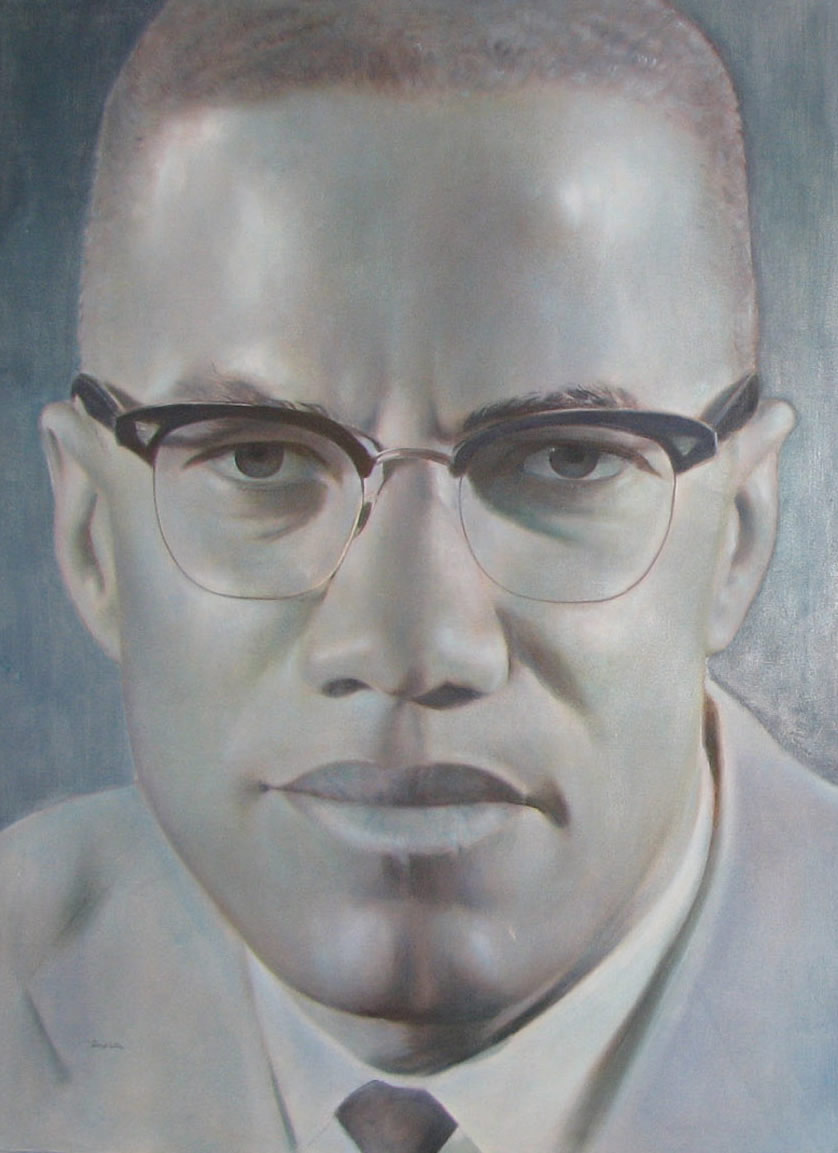 Portrait of Malcolm X by the artist Robert Templeton Portrait of Malcolm X by Robert Templeton, from the collection Lest We Forget: Images of the Black Civil Rights Movement In 1986, composer Anthony Davis's opera X, The Life and Times of Malcolm X premiered at the New York City Opera. It was the first work by Davis, who would go on to win the Pulitzer Prize for Music for his opera The Central Park Five (2019).[373] In 2023, it was performed at the Metropolitan Opera in a production by Robert O'Hara, with Will Liverman playing the title role. It received positive reviews.[374] Arnold Perl and Marvin Worth attempted to create a drama film based on The Autobiography of Malcolm X, but when people close to the subject declined to talk to them they decided to make a documentary instead. The result was the 1972 documentary film Malcolm X. Denzel Washington played the title role in Spike Lee's film Malcolm X (1992).[375] Roger Ebert and Martin Scorsese included it on their lists of the ten best films of the 1990s.[376] Washington had previously played the part of Malcolm X in the 1981 Off-Broadway play When the Chickens Came Home to Roost.[377] Other portrayals include: James Earl Jones, in the 1977 film The Greatest.[378] Dick Anthony Williams, in the 1978 television miniseries King[379] and the 1989 American Playhouse production of the Jeff Stetson play The Meeting.[380] Al Freeman Jr., in the 1979 television miniseries Roots: The Next Generations.[381] Morgan Freeman, in the 1981 television movie Death of a Prophet.[382] Ben Holt, in the 1986 opera X, The Life and Times of Malcolm X at the New York City Opera.[383] Gary Dourdan, in the 2000 television movie King of the World.[384] Joe Morton, in the 2000 television movie Ali: An American Hero.[385] Mario Van Peebles, in the 2001 film Ali.[386] Lindsay Owen Pierre, in the 2013 television movie Betty & Coretta.[387] François Battiste, in the stage play One Night in Miami, first performed in 2013.[388] Nigél Thatch, in the 2014 film Selma[389] and the 2019 television series Godfather of Harlem.[390] Kingsley Ben-Adir, in the 2020 film One Night in Miami, based on the play of the same name.[391] Jason Alan Carnell, in the 2023 season of the television series Godfather of Harlem.[392] Aaron Pierre, in the 2024 season of the television series Genius.[393] Published works 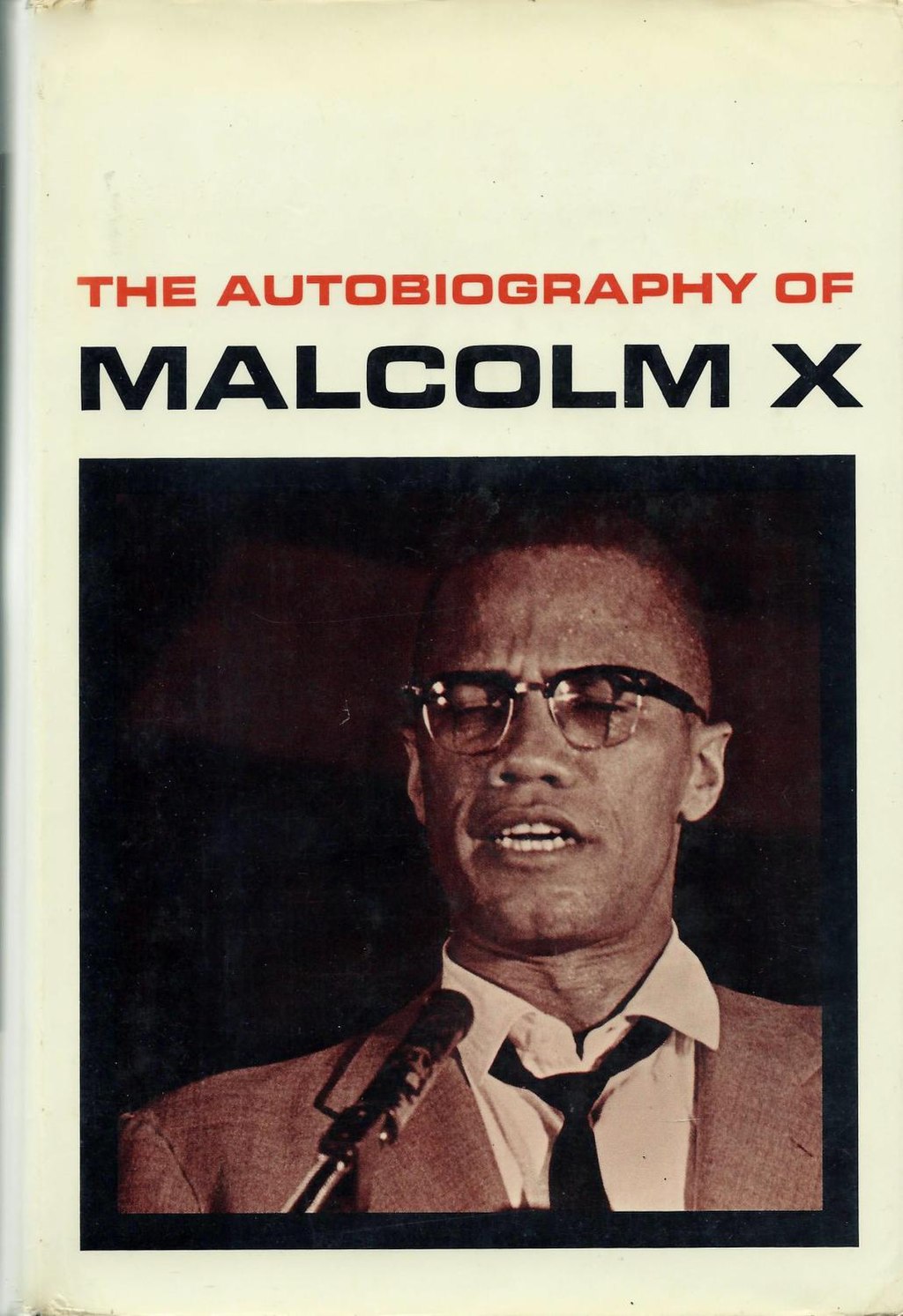 The Autobiography of Malcolm X, first edition The Autobiography of Malcolm X. With the assistance of Alex Haley. New York: Grove Press, 1965. OCLC 219493184. Malcolm X Speaks: Selected Speeches and Statements. George Breitman, ed. New York: Merit Publishers, 1965. OCLC 256095445. Malcolm X Talks to Young People. New York: Young Socialist Alliance, 1965. OCLC 81990227. Two Speeches by Malcolm X. New York: Pathfinder Press, 1965. OCLC 19464959. Malcolm X on Afro-American History. New York: Merit Publishers, 1967. OCLC 78155009. The Speeches of Malcolm X at Harvard. Archie Epps, ed. New York: Morrow, 1968. OCLC 185901618. By Any Means Necessary: Speeches, Interviews, and a Letter by Malcolm X. George Breitman, ed. New York: Pathfinder Press, 1970. OCLC 249307. The End of White World Supremacy: Four Speeches by Malcolm X. Benjamin Karim, ed. New York: Monthly Review Press, 1971. OCLC 149849. The Last Speeches. Bruce Perry, ed. New York: Pathfinder Press, 1989. ISBN 978-0-87348-543-2. Malcolm X Talks to Young People: Speeches in the United States, Britain, and Africa. Steve Clark, ed. New York: Pathfinder Press, 1991. ISBN 978-0-87348-962-1. February 1965: The Final Speeches. Steve Clark, ed. New York: Pathfinder Press, 1992. ISBN 978-0-87348-749-8. The Diary of Malcolm X: 1964. Herb Boyd and Ilyasah Shabazz, eds. Chicago: Third World Press, 2013. ISBN 978-0-88378-351-1. |
映画、テレビ、舞台での描写 画家ロバート・テンプルトンによるマルコムXの肖像 ロバート・テンプルトンによるマルコムXの肖像(『Lest We Forget: Images of the Black Civil Rights Movement』より 1986年、作曲家アンソニー・デイヴィスのオペラ『X, The Life and Times of Malcolm X』がニューヨーク・シティ・オペラで初演された。この作品は、後にオペラ『セントラル・パーク・ファイブ』(2019年)でピューリッツァー賞音楽部門 を受賞することになるデイヴィスの処女作であった[373]。2023年、ロバート・オハラによる演出でメトロポリタン歌劇場で上演され、ウィル・リ ヴァーマンがタイトルロールを演じた。好評を博した[374]。 アーノルド・パールとマーヴィン・ワースは『マルコムX自伝』を基にしたドラマ映画を作ろうとしたが、題材に近い人々が話をすることを拒否したため、代わりにドキュメンタリーを作ることにした。その結果が1972年のドキュメンタリー映画『マルコムX』である。 デンゼル・ワシントンはスパイク・リー監督の映画『マルコムX』(1992年)でタイトルロールを演じた[375]。ロジャー・エバートとマーティン・ス コセッシはこの映画を1990年代のベスト10作品に選んだ[376]。ワシントンは1981年のオフ・ブロードウェイの舞台『When the Chickens Came Home to Roost』でマルコムX役を演じたことがある[377]。 その他にも、以下のような描写がある: ジェームズ・アール・ジョーンズは1977年の映画『The Greatest』で演じた[378]。 ディック・アンソニー・ウィリアムズ、1978年のテレビ・ミニシリーズ『キング』[379]、1989年のアメリカン・プレイハウス制作のジェフ・ステットソンの戯曲『ザ・ミーティング』[380]に出演。 アル・フリーマン・ジュニア、1979年のテレビミニシリーズ『Roots』に出演: 次の世代』である[381]。 モーガン・フリーマン、1981年のテレビ映画『預言者の死』に出演[382]。 ベン・ホルト、1986年にニューヨーク・シティ・オペラで上演されたオペラ『X, The Life and Times of Malcolm X』に出演[383]。 ゲイリー・ドゥーダン、2000年のテレビ映画『キング・オブ・ザ・ワールド』に出演[384]。 ジョー・モートン、2000年のテレビ映画『Ali: アメリカの英雄[385]。 マリオ・ヴァン・ピーブルズ、2001年の映画『アリ』に出演[386]。 リンゼイ・オーウェン・ピエール、2013年のテレビ映画『ベティ&コレッタ』に出演[387]。 フランソワ・バティスト、2013年に初演された舞台『ワン・ナイト・イン・マイアミ』に出演[388]。 ニゲル・サッチ、2014年の映画『セルマ』[389]と2019年のテレビシリーズ『ゴッドファーザー・オブ・ハーレム』に出演[390]。 キングスレイ・ベン=アディール、同名の戯曲を基にした2020年の映画『ワン・ナイト・イン・マイアミ』に出演[391]。 ジェイソン・アラン・カーネル、テレビシリーズ『ゴッドファーザー・オブ・ハーレム』の2023年シーズンに出演[392]。 アーロン・ピエール、テレビシリーズ『ジーニアス』の2024年シーズンに出演[393]。 出版された作品  マルコムX自伝』初版 マルコムX自伝』アレックス・ヘイリー協力。ニューヨーク: Grove Press, 1965. OCLC 219493184. マルコムXは語る: スピーチと発言集. ジョージ・ブライトマン編 George Breitman, ed: Merit Publishers, 1965. OCLC 256095445. Malcolm X Talks to Young People. ニューヨーク: ヤング・ソーシャリスト・アライアンス, 1965. OCLC 81990227. マルコムXによる2つのスピーチ: Pathfinder Press, 1965. OCLC 19464959. Malcolm X on Afro-American History. ニューヨーク: Merit Publishers, 1967. OCLC 78155009. ハーバードにおけるマルコムXのスピーチ。Archie Epps, ed. ニューヨーク: Morrow, 1968. OCLC 185901618. By Any Means Necessary: マルコムXのスピーチ、インタビュー、手紙。George Breitman, ed: George Breitman, ed. New York: Pathfinder Press, 1970. OCLC 249307. 白人至上主義の終焉: ベンジャミン・カリム編。ニューヨーク: Monthly Review Press, 1971. OCLC 149849. 最後の演説 ブルース・ペリー編. ニューヨーク: Pathfinder Press, 1989. ISBN 978-0-87348-543-2. Malcolm X Talks to Young People: アメリカ、イギリス、アフリカでのスピーチ。スティーブ・クラーク編 ニューヨーク: Pathfinder Press, 1991. ISBN 978-0-87348-962-1. 1965年2月: 最終演説 スティーブ・クラーク編 ニューヨーク: Pathfinder Press, 1992. ISBN 978-0-87348-749-8. マルコムXの日記: 1964. ハーブ・ボイド、イリヤサ・シャバズ編。Chicago: Third World Press, 2013. ISBN 978-0-88378-351-1. |
| https://en.wikipedia.org/wiki/Malcolm_X |
リ ンク
文 献
そ の他の情報
Copyleft, CC, Mitzub'ixi Quq Chi'j, 1996-2099
☆
 ☆
☆